#elsa analysis
Explore tagged Tumblr posts
Text
Viktor and Elsa
A secret passion?
Viktor Vasko and Elsa Bastion (formerly Arbogast) clearly share a connection. This has been clear since the Defiance flashback

This perhaps shouldn't be that much of a surprise. They are both veterans of the Great War, they have both experienced and still bear the inner scars that come with the tragedy and brutality of war and the suffering it brings.
Elsa in her capacity as a nurse, who no doubt saw all manner of mangled and broken men, and Viktor the muddy, bloody, living hell that was the front line of the trenches. It only makes sense that such people would be able to understand each other in ways others wouldn't.
Elsa has no doubt spent plenty of time treating wounded soldiers and seen the emotional anguish, and so would be able to see through that sour intimidating facade that keeps most people at arms length. While Viktor could find reassurance in the company of a kind and compasionate woman like Elsa
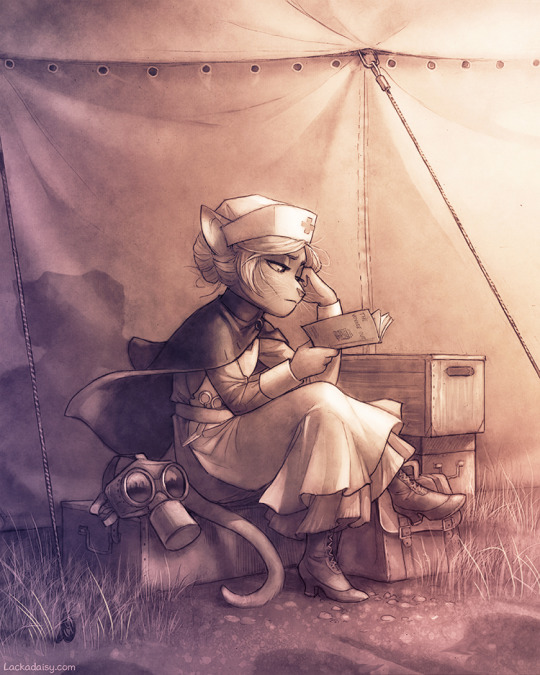
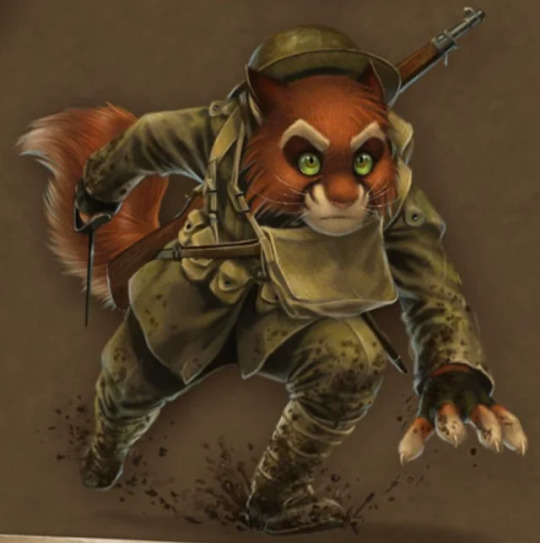

But many fans have found themselves wondering if there could be more to it than that.
Viktor spent some time staying at the arbogast household, and it seems in that time Elsa got to know Viktor very well, learning more about his life than even Ivy, someone that can approach Viktor much easier than most as a stand in daughter to him, and even to the extent she knows Viktor would never have agreed to let her put herself in danger

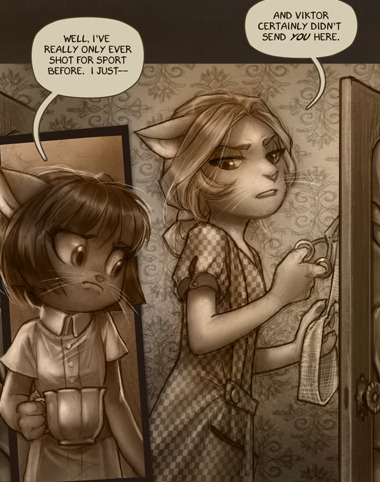

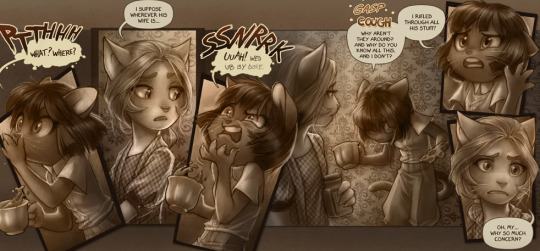

Viktor for his part may also feel more than just friendly towards her, if the face he makes when she is finally able to get through to him by phone to inform him about Ivy putting herself in danger is anything to go by.
Having been in a pit of deep despair over the memory of his far away daughter, plus the poor state of his health with compromised knees and a hole in his chest, hearing from her seems to make that normally scowling face soften


But before we all jump on that bandwagon and "Viktor x Elsa" become our new Lackadaisy otp, we have to consider the jolly British elephant in the room.
Bobby Bastion

Bobby is another war veteran and it was though their service that they met just after the war and later married.
He appears to be a very jolly and affable chap (relative to most bootleggers anyway), which may well be what drew Elsa to him in the first place. Someone who could counter her melancholy from the dark times they went through
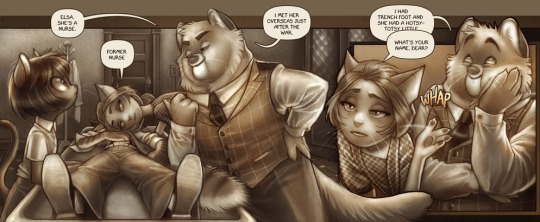
He seems to be very aware and considerate of his wife's relative melancholy, by Elsa's own admission leaving a very lucrative funeral trade in the big city to move too a small quiet community that offered little business but gave Elsa the peace and quiet she needed (like Viktor it seems she hates "noise, noise, noise" thanks to the war).
Their involvement in bootlegging in the first place it seems was to compensate for this and provide the income to sustain this relative isolation

But despite this, perhaps their diffent mindset has become more of a barrier between them rather than something that compliments each other?
As the family illustration suggests, Bobby is relatively content and able to smell the flowers, while Elsa remains haunted. Bobby's humour also seems to have little effect on Elas's mood

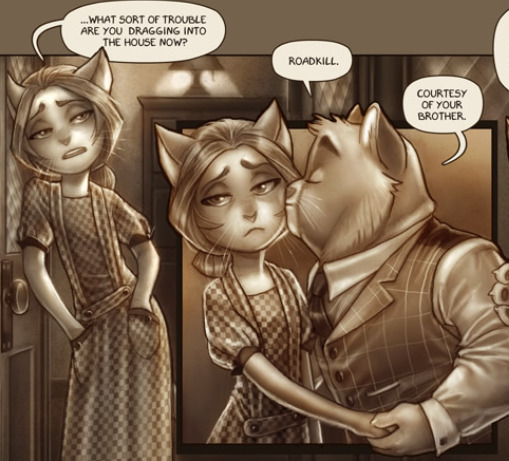
Could it be that Elsa would be drawn to someone like Viktor, someone who suffers from the same trauma as her and may be more willing to admit to the pain, than a husband who despite the best of intentions is trying to just smooth over the problem? Quite possible
But even with that strong connection and bond between them, even if there is a mutual spark, does that suggest an actual affair? That's the big question here.
While arguably not handling his wife's troubles in the best way, Bobby seems to be a loving husband doing his best for his wife who he cares for deeply. Is Elsa the type of person who would cheat on her kind husband for helping in the "wrong way"?
Plus Bobby not only shows no sign of concern about Viktor staying with them and being around his wife, but, (despite his brother in laws interuption) mentions that he was very grateful for Viktor's help and actually saw him as almost "part of the family"

Is this a case of "ignorance is bliss"? Does he simply blindly trust his wife so much that the possibility doesn't even occur to him, or does he know her well enough to be certain that infidelity is something she simply would not do?
But this is all speculation at this point. What do you think?
Is poor Bobby blind to what happened under his own roof? Is it a matter of two people feeling an attraction but tragically unable to act on it due to circumstances? Or is it just an innocent matter of two wounded souls with shells and screams still ringing in their ears recognizing the scars on each other and offering some understanding?
Thanks to @ursiday whose Viktor and Elsa art got my over analysing brain juices flowing again ;)
#lackadaisy#tracy j butler#lackadaisycats#elsa arbogast#bobby bastion#elsa bastion#viktor vasko#viktor x elsa#bobby x elsa#hey look at that i posted a Viktor analysis that doesn't involve Mordecai!#I must be fatally ill#Mind you wouldn't it be funny if Viktor was hopelessly longing for Elsa while Mordecai “repression” Heller quietly did the same for him hah#and by “funny” I mean tragic as all hell
1K notes
·
View notes
Text
"The two of us were connected with our hands held together."
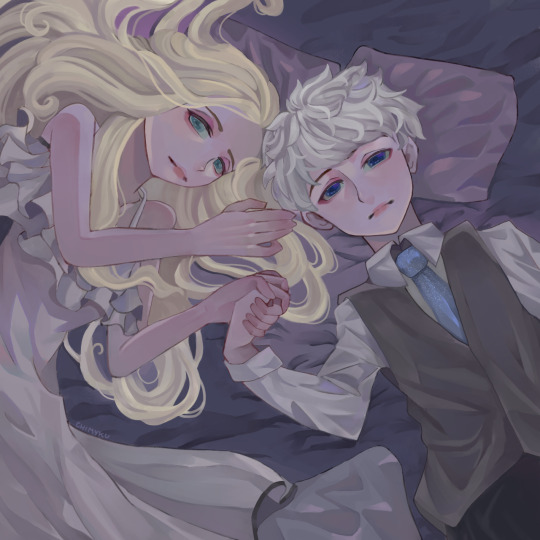
Jelsa siblings AU?!
(Guys hear me out xD)
I recently rediscovered one of my favorite vocaloid songs, "Adolescence" by producers Signal-P and Orange, and I also remembered that some people said Jelsa looks like siblings, so here's an illustration based on that! Go listen to the song as well: https://youtu.be/u-YH22ijXhs?si=GN6U2xPPZw2b3ROv
I like this version better though: https://www.youtube.com/watch?v=nHglIaco2fE
I often hear/read about how Jack and Elsa can pass off as siblings because they supposedly look alike. I personally don't think they do (or maybe that's the shipper in me talking lol) just because they are both light-haired, blue-eyed, and have a pale complexion. I mean, both their hair and eye colors are different shades anyway, that has to count for something, right?! XD
If you haven't heard of the song before, there are basically two major interpretations to it: it can either be viewed as a platonic or romantic relationship between twins. The overall idea is that, as adolescents, they realize that they're growing and that things are no longer the same. By that, no longer the same physically—as in their once similar facial features, hand sizes, etc. are all different now— and from a social standpoint, where it is no longer acceptable to do some things that were so normal for them as twins, such as sleeping in the same bed together (like I said before, you can view it however you like; be it either as the innocent indignance of close-knit twins who were suddenly made to distance themselves, or a tale of forbidden incestuous love). Most vocaloid songs, including this one, are up to interpretation anyway. I might be slightly off though, it has been quite a while since I've delved into the meanings of vocaloid songs. Whether or not to consider this jelsa piece as platonic or romantic, it's also up to you hehehe.
Here's a lovely fanfic I've found from @oni-no-ko that has Jelsa as twins (which reminded me of this song!). Mind the rating before you read it, don't say I didn't warn you XD: https://www.fanfiction.net/s/10339919/1/Behind-Frosted-Doors
I have mixed feelings about this artwork. I haven't tried this art style in a while and though I like how it turned out, I'm not satisfied with the hands lol they're the bane of my existence xD. I also kept going back and forth modifying random parts of the artwork, so I decided to finally post it because I will never be done with it at this rate xD.
#jelsa#elsa x jack frost#jack frost x elsa#elsa frozen#elsa of arendelle#elsa#queen elsa#rotg jack frost#jack frost#jackson overland frost#disney fanart#dreamworks fanart#rotbftd#rotbtfd#adolescence#vocaloid songs#rise of the guardians#frozen#sorry for the long description I got too excited talking about vocaloid analysis#its my favorite hobby aside from sobbing about my ships#and drawing lol#platonic jelsa#or is it#snowtp#royalfrost#cw: incest#depends on how you look at it#chimyku art#artists on tumblr#digital illustration
87 notes
·
View notes
Note
I’m bored and I really enjoy your opinions on Disney, so I thought you might have something interesting to say to get my brain ticking. I came across a post on Frozen and I was like, “Ah, a perfect starting place for dropping you an ask.” I’ve never really been that bothered by Frozen and I don’t know what it is that I’m just not fond about. Maybe it’s that I dislike the characters? Maybe it’s that they didn’t really have any established rules for the way magic worked in that universe and thus had anything they wanted happening? Maybe it’s the twist villain? I don’t know, it’s probably just the characters that they tried to make so cool and girlboss!
Elsa is made out to be this awesome protagonist that is never in the wrong and that grates me. She has flaws, but the film doesn’t act like they’re flaws. She runs away out of fear and shame for not being able to control her powers, but then two seconds later she’s singing “Let It Go” and making giant ice castles and bringing snowmen to life?! And “Let It Go” is super annoying for the fact that Elsa starts off worried and upset (fair enough, she’s just ran away from her home, her kingdom, her sister whom she hasn’t seen in years, she lost control of her powers) but then immediately turns round and is like, “Actually, it’s not my fault and I’m fine as I am and I don’t need any of those responsibilities!�� Which would be fine, but she also finishes the film with the same attitude!
Anna, too! Naive and optimistic and perhaps a little too trusting, she never realises that even if Han hadn’t turned out evil, Elsa had every right to be worried over their marriage. She never realises that it’s partly her fault for revealing Elsa’s powers (and she definitely doesn’t apologise). There’s a lot she doesn’t realise, and the only lesson she takes away from it all is that Christoff loves her instead of Han.
Oh my days, I’ve just realised how ridiculously long this has gotten, super sorry! Have a lovely day!
Let’s do this! For fun!
1. They don't need to establish exhaustive rules for how magic works in their world.
Red Riding Hood doesn't explain how the Big Bad Wolf can talk-it just explains that he can. Cinderella doesn't explain how Fairy Godmothers work, or why the spell should only last until midnight—it just explains that she casts one, and it does only last until midnight. Beauty & the Beast does not explain how, after The Beast has died, the "breaking of the curse" could bring him back to life. After Belle confesses her love, he should just go from dead beast to dead human, for all the explanation they give.
Beauty & the Beast also famously refuses to explain (explicitly) why all of the household were cursed, along with the castle and the Prince. But what it does explain is, "there's a curse, it was put in place because of a defect in the Prince's character, and there's a time limit on it's ability to be removed, which can only happen if the defect in his character is overcome."
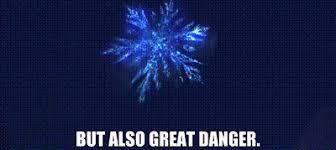
The whole point of having magic in the story is just as a tool...to create a plot. You don't have to explain everything; you just have to explain what will affect the characters. So, Frozen says, very plainly in the beginning: "you can either be born with magical powers or cursed with them in this world, and trolls are the experts on how magical powers work. The way Elsa's specific magical powers work is, they're beautiful, but powerful, and they're tied to her emotions. Therefore, if her negative emotions control her, her negative emotions control those powers. Also, if you're struck with magical powers in the head, the effects can be removed with memory alteration. If you're struck with magical powers in the heart, the effects can only be removed by an act of True Love.
Also, here's an explanation of what counts as 'True Love." They actually do way more explaining than the average fairy tale. And they set you up really nicely to receive that explanation by having the opening scene be a song that describes Ice Magic as “beautiful/powerful/dangerous/cold/ice has a magic can't be controlled.” Etc.
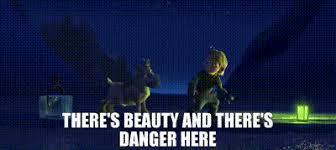
If you were wondering what limits there are on Elsa's powers, and whether or not she can just make anything out of ice, and how it's possible for her to bring inanimate snow to life
—well, you're focusing on the wrong things for this kind of story.
It's not that important for a fairy tale like this one. In a superhero story, limitations on powers would be important. Because the point of a superhero story is, "how am I going to take selfless responsibility for what I'm able to do?" And if you don't know the boundaries on "what I'm able to do," then you can't communicate that point clearly. That's why we need to know that Superman can see through just about everything, but not lead. That's why you need to know that Elastigirl can't stretch in the cold. You can't know how to take responsibility for your abilities if you don't know what they are and are not.
But Elsa? The point of Elsa having powers is not as a metaphor for her unique skills. That's what it would be in a superhero movie.
Like, in superhero movies, Spidey's ability to stick to walls is supposed to be a reference to like, your ability to...l don't know, draw really well. How is Spidey going to use his ability to stick to walls for the good of others = how are you going to use your ability to draw for the good of others, because it's something special and unique to you, you have something to offer, are you going to use it selflessly, etc.
But for Elsa, that's not what it's about. Her powers are just a metaphor for how what's going on inside of her effects everyone around her, relationally. And it's still relatable. But not in a "skills" way. Just like all of us non-superpowered people: "if you let fear control you, you'll hurt everyone around you. But if you let love cast out fear, you'll love and be loved."
That's what's so good about this movie. When you look at it like that, you realize the powers aren’t the point.
Elsa isolates because she thinks that'll keep her from hurting everyone (fear controls her) but actually, by isolating, she's still hurting everyone-nobody in the kingdom gets to see their beloved ruler, and her sister is hurt, relationally, and feels unloved and shut-out, enough to trust the first scoundrel she meets-etc. See how the powers just make the story interesting, but they're not the point of the story? If Elsa's powers were replaced by "frantic outbursts of human temper" the story could be told in a lot of the same ways. But that's a post for another time.
So I don't think you disliked it because of the powers not being "established." "Whatever they wanted to have happen" did not happen, in the story. They laid out the rules that were relevant—“if fear controls you, it'll lead to great danger/but an act of true love can thaw a frozen heart."—and then they followed those rules in an interesting and consistent way.
2. The "twist" villain worked perfectly for the story.
A good villain is supposed to be the opposite of whatever your story's message is. Frozen's is, "Self-Sacrificial Love Casts Out Fear." Elsa is afraid she'll hurt everyone around her, and afraid that makes her unloveable-so she's a control freak over her circumstances. Anna is also afraid she's unloveable-simply because she's shut out and unknown-so she's always trying to control who she keeps in her life. Hans is both "unknown" and "controlling." He's "unknown" in two ways—1, nobody sees him in the shadows of his brothers in his own kingdom, and 2, nobody in Arendelle "knows" his true nature, especially not Anna. But the difference is, where our heroes don't like being unknown, Hans does, and uses it to his advantage, because he's also "controlling." But unlike our heroes, who learn that "control" is not the way to love, Hans is willing to do anything to stay in control. Which is, always, rooted in fear, too. Hans is just afraid he'll never get a throne. So. You see that he foils the two main characters perfectly.
But the main point of Hans is that he's not self-sacrificial, he's self-serving, which is the opposite of what the story claims "True Love" is.
Why's the "twist" part important? Because he uses the main characters' fears as a weapon to serve himself, and he couldn't have done that, for these two particular characters, by being anything but a liar. Anna is afraid she won't ever be loved, so he pretends to love her to get something for himself. Elsa is afraid she'll hurt everyone, so Hans pretends to be protecting everyone from her. And honestly, that's another core of the movie-love that is self-sacrificial, true love, can't be separated from truth. Anna can't really "truly love" Elsa in a way that HELPS Elsa feel loved if she doesn't know Elsa's flaws. Elsa can't "truly love" Anna if she's refusing to know Anna by always shutting her out. And Hans comes along and doesn't let himself be "truly known." Perfect.
So, the movie says "Self-Sacrificial Love Casts Out Fear" and Hans, the villain, says, "Self-Service Uses Fear As a Weapon."
So I don't think you disliked the "twist" villain. Because it wasn't just an empty "shock-jock, look how edgy we are, to make the Prince the bad guy" move. It was the right move, for this story and these characters.
3. I think your definition of "so cool" and "girlboss" might be different from what l understand those terms to mean, because none of the characters fit those descriptions.
Anna (as we understand her throughout the story) is introduced like this:

And she's constantly dropping stuff and getting into awkward social situations-and she basically makes zero correct decisions, for the entire adventure. Tries to fight wolves like a girlboss-and instead accidentally knocks her guide out of the sleigh and has to be thrown to safety while she ruins his livelihood. Tries to climb a cliff with zero experience-looks ridiculous and falls. Tries to talk her sister into lifting a curse and insists that she knows best because her sister would never hurt her-gets crippled, because her sister absolutely does hurt her, and totally fails. Tries to marry a handsome prince-really bad judgement of character, totally duped, basically would've died without help from the weakest and most mentally-confused character in the movie, Olaf. The only "girlboss" moment you could argue she had was punching Hans in the face at the end of the movie, and I would argue that that one moment, in the face of all her failures and humiliation throughout the movie, and in the face of him as a vile villain? That moment is okay.
Also, the whole way they pace that moment is still in-character for Anna. It's still like she's not doing the "dignified" thing. She delivers her little one liner, "the only frozen heart around here is you," and then turns around to walk away with her nose in the air, like she's
"above it all." Which frames the moment where she turns around and punches him like a joke. It frames that moment like it's a satisfying, but still "not decorous, not dignified," thing to do. It would've been "cool" and poorly received if Anna, the character who's always jumping into doing the emotional, awkward thing, had suddenly become the bigger person and risen above her hurt in that moment.
So instead, she punches him. And whatever. He deserved it, blah blah blah. The point is, even that moment isn’t supposed to be strictly “cool” or “girlboss.” It’s just supposed to be “in-character funny.”

See, usually a "girlboss" character knows exactly what the best thing to do is in a situation, and does it well. Or, she gets knocked down, but consistently gets back up and hits harder. Anna does not do any of those things. She keeps trying when she fails, yeah-but it's not because of an inner strength, it's because of an inner weakness. She keeps pushing because she's desperate, and insecure, not because she's awesome and never-say-die. Eventually, after Elsa strikes her and Hans betrays her, Anna does give up. She tells the snowman "we won't (come back.)" after Elsa strikes her. She tells Olaf she doesn't know what love is. It's not until she learns that lesson that anything she tries to do works—and she gives herself up to do it. And that's finally a moment of strength from her, not weakness. As for "cool"-gimme a break.

There's nothing "cool" about Anna. Anna's not good at anything except, at the very end, self-sacrificially standing in front of a sword and getting one punch in on a villain who's already disarmed, defeated and probably slightly concussed anyway. She's not supposed to be "cool" or "girlboss." She's supposed to be "Desperate to Love and Be Loved." And that's what she is, perfectly. "Desperate" is not a characteristic that fits the definition "girlboss" or "cool."

But maybe you just meant "Elsa is so cool and a girlboss." Okay, well, again, depends on what you mean by that. If you mean "having superpowers are cool" okay, well, are they? Is that what the movie is telling you? Because powers basically ruin all of Elsa's childhood and life until the last 3 minutes of the movie. You could be like "come on, she can make snow and ice monsters, glitter gowns, and an entire palace just by dancing. They totally tried to make her 'cool." That's like saying Simba's ability to eat bugs and belch and fight with Nala is "cool." She does all those things at her "Character in the WRONG" moment, in the story, just like Simba living in the Hakuna Matata jungle. Therefore the movie is not trying to tell you that Elsa is cool, it's trying to tell you that Elsa is wrong, but you can understand why she's wrong. You can understand why she feels triumphant for a moment-and then the movie shows you that triumph is misplaced.
I mean, she's taken out by her own falling chandelier. Every time she's confronted with a problem, she runs away. When she gets into "battles of wits," she says the wrong thing, or the shy, shut-down thing, not a girlboss one-liner that shuts the other person up. Elsa's not cool either. She doesn't have the answers, she doesn't save the day-she gets saved.

Both of these characters are desperate, open wounds-—they're needy and they're in the wrong, each in their own way, for the majority of the movie. They're weak, and they have to learn to find strength in love, for most of their story. There's nothing "girlboss" or "cool" about them.
I think maybe what some people make the mistake of is noticing the Frozen mania, and the fact that the two main characters are girls and one of them has superpowers and they other doesn't get with a Prince, and then they get the impression, from that, that the characters are "cool girlbosses." But like...that's like saying Dory from the first Finding Hemo movie is a girlboss. She's so totally not. She's a wreck. A funny, appealing, sometimes-relatable-human wreck. And a good character, but the hype doesn't change who she is, as a character. And who she is, like Anna and Elsa, is just a good character.
4. Elsa does not finish Let it Go with an "I'm Fine As I Am" attitude, and she doesn't finish the movie that way, either.
She finishes "Let it Go" with an "I'm fine up here, isolated from everyone," attitude. And then the movie very quickly proves her wrong by having Anna show up and reveal to her that no, actually, she is not fine up there, because the person she cares about most can still find her and be hurt by her, and the whole kingdom is still reeling from the problems she ran away from.
At the end of the movie the only thing I can guess you got the impression that she's "fine as she is" from was the fact that she's using her powers again.

But like. Elsa's whole problem was never her powers. She wasn't supposed to learn to stop using them. She was supposed to learn to stop living in fear. Instead, she was supposed to lean on love-love that sacrifices for her, flaws and dangerousness and all-and stop trying to control her image and what everyone knows about her.
Because in trying to control what everyone knows about her, she was controlling whether or not they loved her or treated her like a monster. And even running away and singing Let It Go was still an effort to control everything-by not being around people who could treat her like a monster or be hurt by her. Instead, accepting that she might hurt people because she can't always control everything, and trusting that they'll still love and forgive her, was her character arc.
She lives by faith in sacrificial love by the end, not by fear. That's the arc. She does that perfectly.
It was never, "I'm fine as I am." Because the point was never "there's* something wrong with me." It was, "I don't need to fear a lack of control, because true love covers what I can't control." That's all.
4. Anna does communicate to the audience that she's sorry and willing to understand the reasons behind Elsa's secrets.

The lesson Anna takes away from all of this is not "which guy loves me." It's "what is love?" And you know she's learned that because she demonstrates it. If Anna had died-frozen forever-or been cut down by Hans' sword, you realize that Elsa would never have been able to repay that gesture, right? But Anna still made that choice.
Even though it meant Elsa would never repay her. And the point is — excuse me, I know this is long enough, but I feel like you're missing out on something wonderful here—
Anna could have left Elsa to be killed and ridden off into the sunset with Kristoff.

They make it very clear that that is her goal when she stumbles onto the ice, free from the room Hans trapped her in. Elsa is no longer her motivation. She isn't looking for Elsa. She's not trying to get that love she's looked for, from Elsa, in that moment. She's trying to get it from Kristoff, not just for her emotional need-but for the "breaking of the curse" that's killing her in the moment. That whole scene where she realizes he loves her-truly loves her, because he fits the description Olaf gives-is in there to communicate to the audience that he could save her. He could give her what she needs.
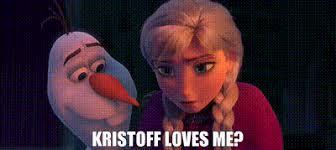
And the reason that's important is that it proves that this is character development: when she chooses not to go to Kristoff, and to go to Elsa instead.
Because it's her, choosing to turn away from the person who could give her something (even if it is "love") and to turn toward the person who can't give her something (Elsa.) Who has repeatedly failed to give her something, for their entire lives.
Anna at the beginning of the movie would've run to Kristoff. That was the whole point of Hans, when it comes to Anna-he represents someone who can fulfill a need in Anna. But when Anna turns away from Kristoff and runs to save Elsa instead, Anna is demonstrating what she's learned —that love isn't about her own needs. It's putting someone else's needs before yours. She stands between Hans and Elsa, with the full expectation that she's not going to get anything out of it, not even a guarantee of E/sa's love in return. And her own needs will NOT get met if she puts Elsa's first.

And that's what she does. Whereas, at the beginning of the film, Anna would not have done that. Because that's not what she thinks love is. She hasn’t realized that yet.
She thinks love means closeness. And that does come with love. But that's not love. Love is, like Olaf says, putting someone else's needs before yours. But the whole movie, Anna is not working to put Elsa's needs before her own. She's working to change Elsa's mind, now that she knows the truth, so that she and Elsa can be "close again." She's climbing that mountain and arguing with Elsa, because she thinks that all that stood in their way before was this secret that's been uncovered. And sure, Anna has always been willing to “be there for” Elsa, but you have to see that Anna wanted that to come with Elsa being there for her, in return.
Which would be nice. But it's not true love. True love is being there for someone even when they refuse to be there for you. Because that's putting their needs before yours.
Thanks for the super long ask! That was fun! I hope you enjoyed reading as much as l enjoyed writing-I think sometimes we judge Frozen by the mania that followed, not the good quality that actually caused the mania, and deserved the mania, though. Anyway 😂

Guards! Take them away! Back to the theater with you! Watch the movie again!
#just kidding#this was fun#thanks for the ask#asked#answered#frozen#Elsa#Anna#Disney princesses#Kristoff#frozen 1#frozen 2013#meta#analysis#storytelling#writing#characters#character analysis#frozen mania#Queen Elsa#Queen Anna#Princess Elsa#Princess Anna#Olaf#Sven#Hans of the southern isles#Hans#trolls#Disney critique#frozen hate
107 notes
·
View notes
Text
Fixing Frozen 3's questions at 2024's D23 Expo
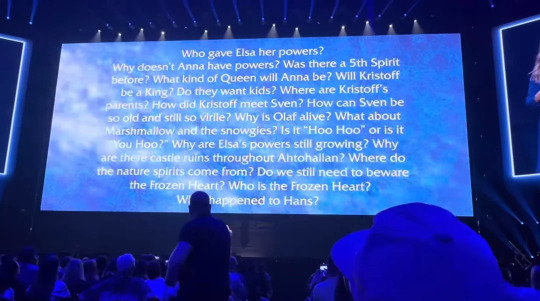
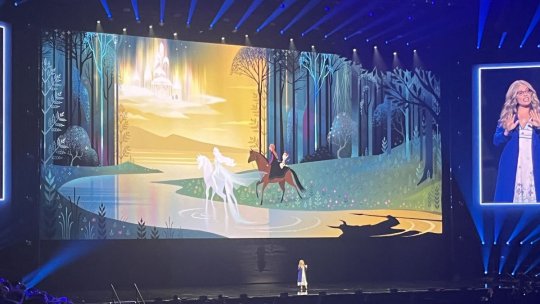
On August 9–11, 2024 at D23, Frozen co-director Jennifer Lee revealed questions that may or may not be answered in Frozen 3:
Who gave Elsa her powers?
Why doesn't Anna have powers?
Was there a 5th Spirit before?
What kind of Queen will Anna be?
Will Kristoff be a King?
Do they want kids?
Where are Kristoff's parents?
How did Kristoff meet Sven?
How can Sven be so old and still so virile?
Why is Olaf alive?
What about Marshmallow and the snowgies?
Is it "Hoo Hoo" or it is "Yoo Hoo?"
Why are Elsa's powers still growing?
Why are there castle ruins throughout Athohallen?
Where do the nature spirits come from?
Do we need to beware the frozen heart?
Who is the Frozen Heart?
What happened to Hans?
One word: disappointing. These questions are like tossing dung at a wall and hoping one of them will stick. They are either incredibly redundant (e.g. Olaf alive, Elsa's powers growing), unnecessary (e.g. Kristoff meeting Sven, the origin of Elsa's powers, castle ruins, the spirits origin) or obvious throwaway questions (e.g. Yoo Hoo, Sven's virility).
And why are the only questions about Elsa all about her powers? Does Lee genuinely believe people only like Elsa because she has ice powers? Seriously look at the questions about Anna and Kristoff--these questions ask about their lifestyles. Do they want kids? What kind of rulers will they be? Meanwhile Elsa gets two questions and they're all about her POWERS.
And why are there no questions concerning the relationship between Anna and Elsa? I thought their sisterly bond was what Frozen was all about. Not Elsa's magic. Not convoluted mythology. Not Kristoff and Anna being rulers and starting a nuclear family. These questions are seriously missing a HUGE part of why Frozen became a hit.
So I've decided to formulate a different set of questions, or rather a more through set of questions, which build upon Lee's questions, and hopefully better address the characters and themes of Frozen and Frozen 2:
Characters
The personalities, the journeys they undergo, the choices they make, the consequences they endure, and the relationship they have with each other are vital to creating memorable characters that resonate with audiences. Frozen set the groundwork, Frozen 2 destroyed it, now its up to Frozen 3 to build it back.
Elsa
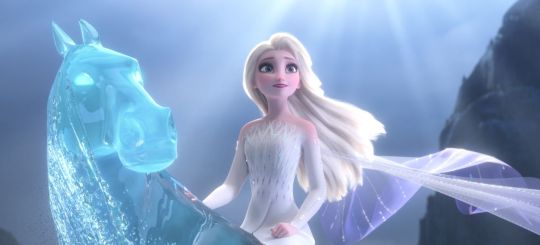
Is Elsa happy in Athohallen?
Does she miss being queen?
Does she miss living in Arendale with Anna?
What is her role as Fifth Spirit?
What does Elsa do in Athohallen?
Does she want a partner?
Does she want kids?
Does Elsa still have social anxiety or any other mental health issues she struggles with? How does this effect her new lifestyle?
What does Elsa think of Kristoff and his relationship with Anna?
Does Elsa think Kristoff will make a good king?
Has Elsa forgiven Hans?
Is Elsa the frozen heart?
Anna
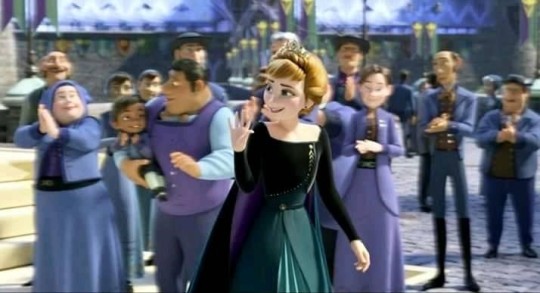
Is Anna happy being queen?
Does she miss being princess?
Does she miss living with Elsa?
What does she think of Elsa abdicating the throne to live in Athohallen?
Is Anna ever worried about Elsa living in a glacier that tried to kill her?
What is her role as queen?
Does Anna feel she can be as good as a queen as Elsa?
Does she think Kristoff will make a good husband?
What does she think of Kristoff being king?
Does she want kids?
Has Anna forgiven Hans?
What does Anna think of her parents, specifically in how they treated Elsa and her as children?
What does she think of the trolls as her in-laws?
Kristoff
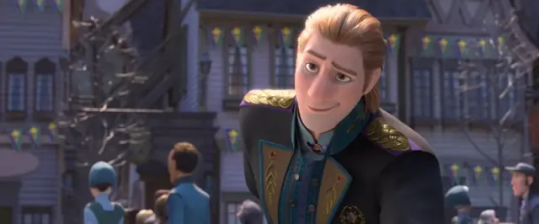
What does Kristoff think of being king?
How is Kristoff adjusting to his radically different lifestyle?
Does Kristoff miss being a ice harvester?
What do the people think of a commoner like Kristoff marrying the queen?
Does Kristoff still love ice?
What about Kristoff's misanthropy? Did that magically go away when he dated Anna?
Does Kristoff think he will make a good husband?
What does he think of Elsa's abdication?
What happened to his parents and why is he an orphan?
Does he want kids?
Hans
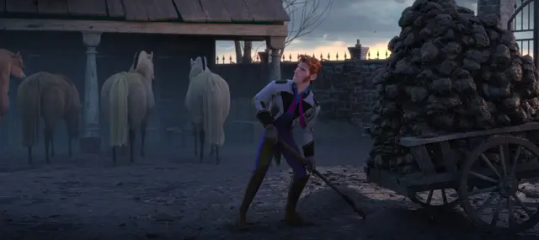
Will Hans return to the franchise?
Will Hans be redeemed?
Does he want revenge?
Does he still want the throne?
Will he ever find a place of his own?
What does Hans think of Anna as queen?
What does Hans think of Elsa's abdication?
What about his parents and twelve older brothers?
Did he have a abusive or neglectful childhood?
Is Hans still shoveling horse manure as his punishment?
Is Hans the frozen heart?
Olaf

How does Olaf feel about being the only sentient snowman of his kind?
Does Olaf wish he was human?
How do other people treat him?
Does Olaf see Elsa as his mother and Anna as his aunt?
Will Olaf reach adulthood?
Can Olaf physically grow?
Does he miss living with Elsa?
How does he feel knowing that if Elsa dies he will die as well?
Will Olaf ever stop being a insufferable edgelord? (lol)
Themes
Old and new themes to explore....
Sisterhood. How does living separately effect Anna and Elsa's relationship? How does Elsa cope without Anna's constant presence and unwavering support? How does Anna cope without Elsa's compassion and wisdom? Will living separately cause the divide between them to deepen?
Fear and isolation. Is Elsa afraid of being alone? Is Elsa afraid of her powers spiraling out of control again? Is Anna afraid of failing to live up to expectations as queen? Does she feel lonely without Elsa always by her side? Is being queen a lonely endeavor? Is Elsa afraid of Athohallen (it literally froze and held her hostage when she got too curious, lol)?
The duty/role of a ruler. Now that Anna is queen, how does that effect the people? What do they think of Elsa's abdication? What do they think of Anna being queen? What do they think of Kristoff being their king? What are the qualities of a good ruler? What sort of constitutional duties are there to perform?
Self-discovery and transformation. How will Elsa and Anna discover new things about themselves or about each other? Will the journey they undergo change them for the better or the worst? Will Elsa's role as fifth spirit drive her further from her humanity? Will Anna's role as queen isolate her from her sister and her people or drive her closer to both?
Redemption and forgiveness. In Frozen, Elsa redeemed herself when she thawed Arendale. The people, who she had nearly accidently killed, forgave her and happily ice skated with her at the end. If Hans is redeemed in Frozen 3 then the theme can continue anew. Redemption is all about transformation. Can someone flawed change for the better? Or are some people's crimes so evil that they are irredeemable? Can we forgive those who wronged us even if they aren't sorry?
Norse mythology. Fate, rebirth, knowledge, sacrifice are a few of the central themes of Norse mythology. The Æsir (e.g. Odin, Frigg, Thor, Loki, Balder, Hod, Heimdall and Tyr) and Vanir (e.g. Njord, Freyr, and Freyja), the Nine Realms, Yggsdrasil. How can they be weaved convincingly into Frozen 3, when 1) it takes place in 18th century Norway and 2) the first film was largely based on a fairytale and classic disney references? Will they ever acknowledge how Christianity replaced paganism? (probably not since this is Disney).
Conclusion
What do you think? Feel free to add some questions. Please be respectful.
#disney frozen#frozen#frozen 3#disney#frozen elsa#frozen hans#frozen 2#frozen theories#prince hans#hans#anna frozen#kristoff frozen#kristoff bjorgman#hans westergaard#d23#d23 2024#d23 expo#hans frozen#olaf#olaf frozen#elsa#fan theory#frozen analysis#redeem hans
105 notes
·
View notes
Text
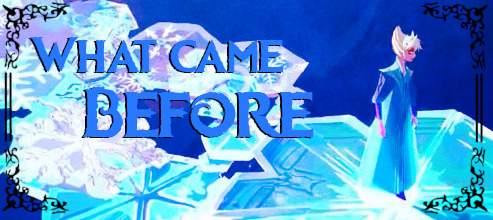
Previous Versions of Frozen (Rewrite)
The development of Frozen is famously known to be messy and obscure. Messy, because of the many last-minute changes made even months before the film released. Obscure, because the many versions there were before the final film are kept secret, with only slight tidbits being released and shown, leaving the previous stories being up to one's own imagination.
In my previous attempt to uncover the previous versions of Frozen, there was a lot of information left out or unknown to me at the time, and even some things I got wrong. Thus, I wanted to do a more in depth look at the possible previous Frozen stories, and update any misinformation.
Feel free to comment sources if there is something I missed.
Part 1 - Before Frozen
As everyone knows, Frozen was first considered to be an adaptation of Hans Christian Anderson’s The Snow Queen. However, over the development of the film, the creative team had decided that it would no longer be an adaptation, as at this point, they were just inspired by the fairy-tale and some of its themes – a Snow Queen, an Evil Mirror, an Act of True Love, and a Frozen Heart. Everything else was left alone, with only fan interpretations of what else could’ve been used, but never officially stated.
Before Frozen was even considered, there were couple attempts at adapting The Snow Queen. A common mistake made by many fans is incorrectly assigning concept art, songs, and story ideas from earlier adaptions of The Snow Queen. However, these versions are not actually Frozen, but completely different stories and attempts to adapt the fairy-tale.
The Biography Attempt -- 1937 – 1942
The first attempt at adapting the Snow Queen was to include the story in a bio-pic of Hans Christian Anderson. The Snow Queen was one of the stories that were going to be told in this bio-pic, alongside his other famous works. The rocky development for this bio-pic began in 1937, and ended in 1942 when the USA entered World War II, as Disney shifted into time on War Propaganda, officially halting the production of this project.
The first completed concept of the Snow Queen segment specifically was coined by Mary Goodrich in 1938, a researcher, who wanted to explore the theme of regeneration through faith. It was very faithful to the original tale, and was actually fully complete. However, Norwegian-born researcher Karl Berggrav dismissed the story. He said that while it was a technically good film, with the story being well-written and had no loose ends, it was boring and uninspired.
"This story rounds off everything nicely and ties up loose ends, but it is very uninteresting and just fades out into nothing, or worse than nothing, banality. It is hard to make good animation out of it.” - Karl Berggrav, The Art of Frozen, pg. 10
Walt Disney himself attempted to adapt the story in 1940, but as a live action and animated film. Hans Christian Anderson everyday life would be filmed in live action, while his stories were to be animated. This was going to be a co-production with Samuel Goldwyn and his new studio Samuel Goldwyn Productions, where they would film the live-action sequences.
The Snow Queen -- 1990 – 2006
There were multiple attempts at adapting The Snow Queen during the renaissance era and after. Harvey Fierstein took a chance to pitch an idea for The Snow Queen, but it was shot down. Even Glen Keane attempted to try his hand at an adaption, but just couldn’t find a way to turn the Snow Queen into the sort of fully realized character.
Then, a new team took on the adaptation in 2000. The main idea that the creative team wanted to have was to omit the Trolls and the mirror, trying to explore different ways for Kai to be abducted by the Snow Queen. There was one version of Kai wanting to impress Erica (Gerda's first name change) by joining a whaling ship. The Snow Queen was often shown in artwork riding an orca all over the sea.
There were other versions that followed this initial premise with more comical side characters, ranging from penguins to walruses to, of course, Snowmen. The strangest outline for this version was how Greta (another name change for Gerda) was a devious gold digger, leading Kai to marry the Snow Queen instead.
The Snow Queen was described as a 'Taming of the Shrew" type character, who had a frozen heart that needed to be melted away by the warm and loving Kai.
I love The Taming of the Shrew idea. Take Martha Stewart. She’s tough, smart — a worthy adversary. If she were a doormat of a woman, no one would go after her. -Michael Eisner, Disney War
The artwork for this version was considered to be beautiful and inspiring, but the narrative was simply not compelling enough. Thus, the story was ultimately scrapped and shelved.
The below concepts are often mistaken for early ideas for Frozen, often named early designs for Anna, Kristoff, and Elsa - however, they are actually from the 2000-2003 version of The Snow Queen, while others are from even earlier versions, and are featuring completely different characters.
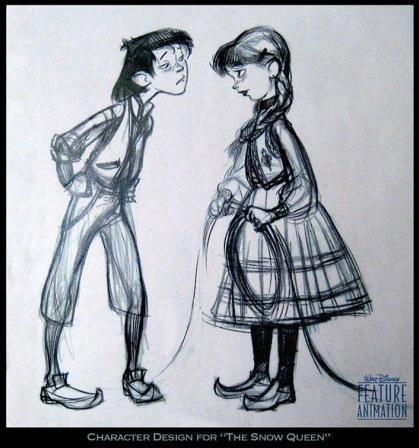
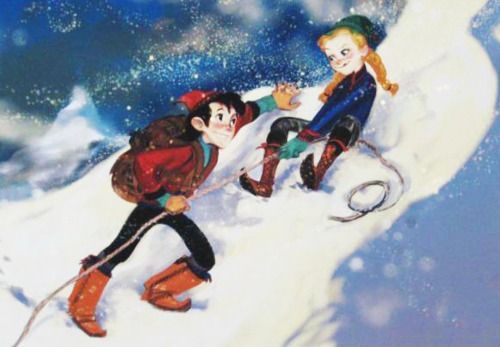
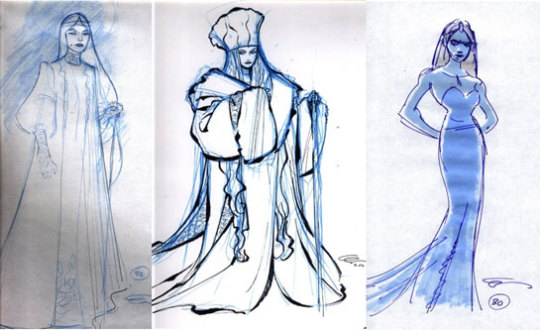
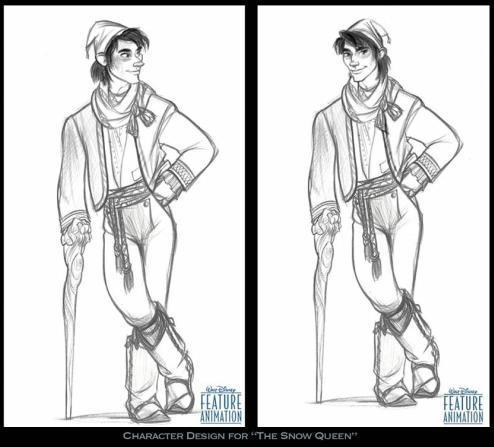
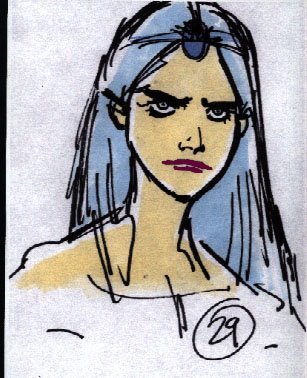
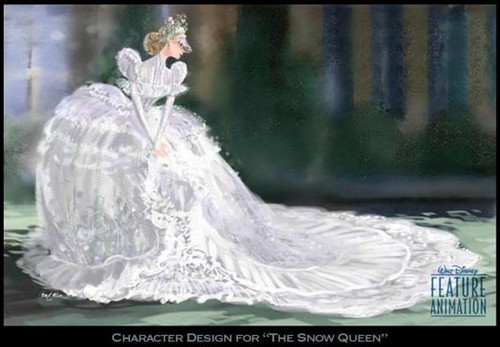
The project was later brought back in 2006, but not for animation - but instead as a stage musical for Tokyo DisneySea at thier Broadway Music Theater. It was going to be directed by Amon Miyamoto, written by John Weidman and Glenn Slater and Alan Menken writing the music. However, it was also scrapped.
The reason I bring this version up, is because a song penned by Slater and Menken is often pushed as early love song that Kristoff was supposed to sing. However, it was not a Kristoff song at all. Love Can't be Denied was a song that was written for this stage musical, with no real details about who it was written for or its purpose in the plot.
youtube
There are many reasons claimed why, but it is often contributed to Disney wanting the Snow Queen Adaptation to be a film, not a stage show. Menken was even reported to try his hand at making it an animated musical, but it never went through.
For years, (Disney had been) working on “The Snow Queen,” first as a stage piece, and then as an animated film, but that got shelved. Clearly, animated films are big commitments and it takes a lot for Disney to greenlight one. - Alan Meken, Jim Hill Media
Part 2 - Previous Versions of Frozen
After John Lasseter was given the reigns of Disney Animation Studios after the Disney merger with Pixar, he wanted to try and adapt this story again. Lasseter convinced his old friend Chris Buck to come back to the studio, and try his hands at another Snow Queen Musical film. Thus, the development of Frozen officially began.
"I pitched several ideas to John, and ‘The Snow Queen’ was one that he'd been interested in for a while. I pitched a musical version of it that he seemed excited by. So we started developing that project. This was back in 2008, around September.” - Chris Buck, The Art of Frozen, pg. 11
Starting 2008, Frozen went through a few versions before Jennifer Lee, Robert Lopez, and Kristen Anderson-Lopez entered the production in 2012. While Jennifer Lee was aware of the project while she was working on Wreck-it-Ralph, as the company typically has round-tables for their animated featured where all of their writers can give notes, she was not officially brought on as writer and then later as director, until 2012.
Both of these versions featured the introduction of Anna and Kristoff as replacements for Gerda and Kai, as adults instead of children. However, there were a few different ideas for The Snow Queen character that would prove to be the biggest obstacle.
Anna and the Snow Queen 2008-2010
The first version of Frozen was called Anna and the Snow Queen. There seems to have been a couple attempts at perfecting this story, none of which really made it to the final cut, due to the difficulty of making the Snow Queen character compelling. This version was meant to have hand-drawn animation at first.
Anna and the Snow Queen is very obscure, and not much exists for its early story ideas other than a few ideas sources from interviews and concept art by Claire Keane.
The Snow Queen Character (she was given the name Elsa at this stage) was based off of Bette Midler (some sources say that she was also meant to be her voice actress) She would take on a very Diva persona, and was of course a villain. Anna at this time was depicted as 'up-tight', and often was shown as some sort of secretary or assistant to the Snow Queen.
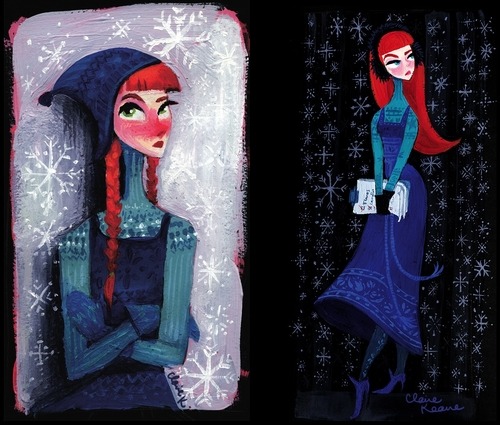
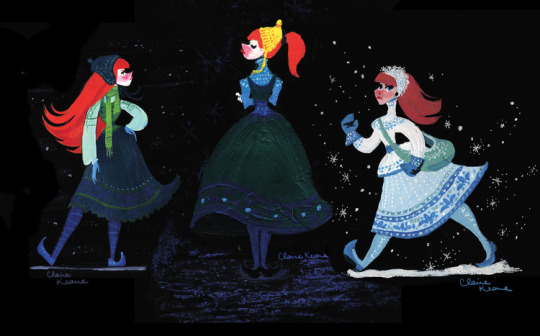
Kristen Bell was cast as Anna before anyone else had joined the team, after she had initially auditioned for the role of Rapunzel for Tangled. Josh Gad was cast a little after, however the Olaf he was voicing was a very different character, much like Anna.
"I was originally involved in the project when it was a 2D effort and it was called Anna and the Snow Queen, and it was completely different. Completely different. Megan Mullally was playing Elsa and it wasn’t really about sisterhood at all. I think it had more to do with the source material of Hans Christian Andersen’s story. When I did that version, Olaf was a different character entirely." - Josh Gad, MSN Entertainment
What the story for this version is often conflicting. Anna goes to the Snow Queen to have her heart frozen after she is dumped at the alter, releasing Elsa from an ice prison. The below concept art by Claire Keane shows Anna as a bride looking for the Snow Queen, supporting this interpretation.

However, other artwork by Keane suggests that Anna is possibly working for the Snow Queen as an assistant of some kind, as shown in the concepts below, and is also supported by the 'up-tight' secretary Anna concepts. It is possible, however, that after going to the Snow Queen to freeze her heart, she ends up working for her. You can also see the Bette Midler inspirations in some of Elsa's character designs.

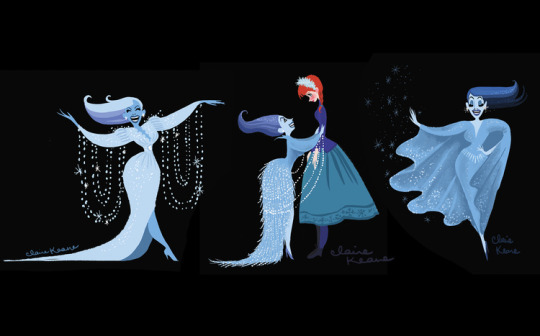
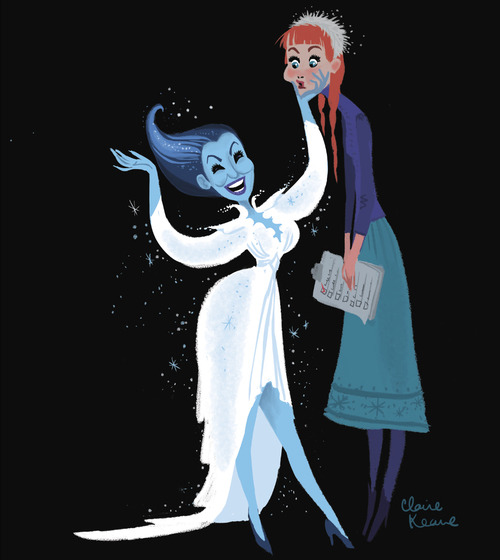

After this period, Anna and The Snow Queen was actually shelved for around one year in 2010, before being brought back in 2011 and renamed to Frozen. It was also around this time that the idea for it to be hand drawn was scrapped, with the film shifting to 3D animation.
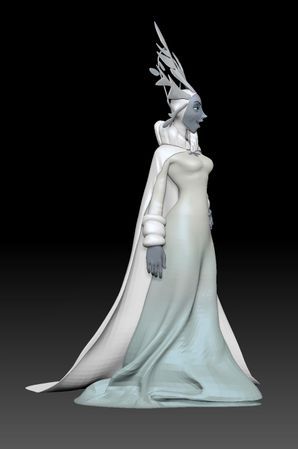
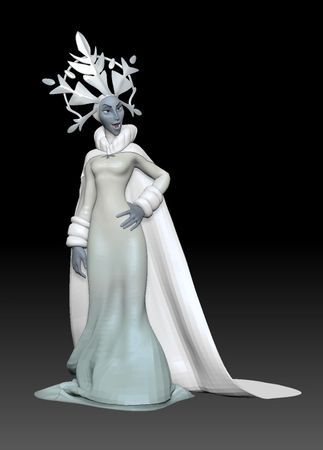
It was seemingly brought back with a story about a prophecy that says that Arendelle would be destroyed by a "Ruler with a Frozen Heart." The characters in the story would assume that this was Elsa, the self-proclaimed Snow Queen (Anna and Elsa were not royalty at this time, nor were they sisters) only for it to be revealed that it was Hans (possibly named Admiral Westergaard).
Frozen was to open with a prophecy that "a ruler with a frozen heart will bring destruction to the kingdom of Arendelle." We're then introduced to Anna, our pure-hearted heroine, and Elsa, an unrelated evil Snow Queen. We learn Elsa is a scorned woman; she was stood up at the altar on her wedding day and froze her own heart so she would never love again. Both Elsa and the audience assume she's the villain from the prophecy. Fast-forward to the final act: Elsa creates an army of snow monsters to attack our heroes while Kristoff has "a Han Solo moment" and comes to help Anna. To halt Elsa's attacking army, the two-faced Prince Hans (Admiral Westergaard) triggers a massive avalanche—not caring that the avalanche also puts Anna, Elsa, and all of Arendelle in jeopardy. Anna realizes Elsa is their only hope, so she convinces her to use her powers to save the kingdom. The twist is that the prophecy from the beginning is actually not about Elsa, but about Hans—he's the one with a metaphorical frozen heart because he's an unfeeling sociopath. Elsa's heart is then unfrozen allowing her to love again. - Peter Del Vecho, Entertainment Weekly
This is also supported with what Santino Fontana says in his interview with Paul Wontorek. He claims that he was hired and paid for his lines in 2011, way before Jennifer Lee was officially involved with the project in 2012, and just after Frozen was brought back from its year hold.
This puts into perspective any claims about Jennifer Lee basing Hans' character after her ex-husband, or that Hans was originally meant to be a good guy until they needed a new villain to replace Elsa. Hans was always meant to be the real villain of Frozen and was seemingly created as soon as Anna and the Snow Queen became Frozen.
The Story of Sisters -- 2011-2012
During one of the round-table sessions, in which Jennifer Lee was involved in but was still not working on Frozen, someone within the session suggested that Anna and Elsa should be sisters. This was the first major breakthrough that helped shape the story.


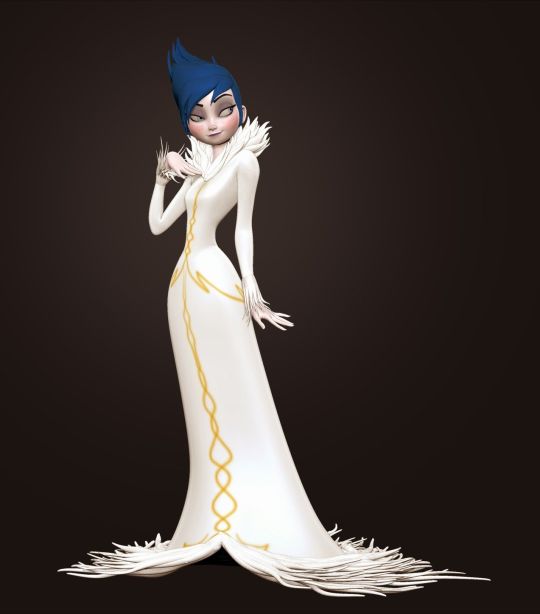

This famous version of Elsa (onionElsa!) is meant to be based off of Amy Winehouse. It is unclear when Elsa's backstory transitioned from being that of a woman who was dumped at the altar, and being the more tragic villain that was forced to hide her magic.
Regardless, it was explained that this Elsa had ran away from her kingdom, and later on kidnapped Anna away from her wedding with Admiral Westergaard, trying to freeze her heart so that Anna would understand how she felt. It ended in the same way, however, with Hans being revealed as the true villain and Elsa getting a redemption.


It was also around this time that Anna's character was also getting a much needed re-working. Anna's 'up-tight' personality was removed with the help of Kristen Bell, who always had issues with Anna’s characterization. She pushed for Anna to be more quirky and awkward, with a strong desire for love and companionship. Idina Menzel was also brought on at this time, where the two actresses prepared a song (Wind Beneath my Wings) to see how their voices would match up.
This deleted scene below showcases this version of Elsa, voiced by Idina Menzel.
youtube
"We did a version where the Snow Queen was the villain, but we wanted to end with them reunited, and it was very hard to redeem her at the end. We decided on an adventure about two people who initially misunderstand each other; it allows for the bonding at the end.” - Peter Del Vecho, The Art of Frozen pg. 12
Jennifer Lee started on the project after all of this was already established, and tried to work out quite a few things with the story. Robert Lopez and Kristen Anderson-Lopez also came onto the project, and tried to write a few songs for this version - although, they didn't really like the story all too much.
One of the songs we know from this version was We Know Better. Interestingly, this is actually not the full song. It is supposed to end with Elsa's turn to becoming ‘evil’, and Anna becoming her 'up-tight' persona. This was omitted with a lot of earlier scenes of Elsa's evil nature (with the exception of the above clip) because the creative team wanted to try and distance Elsa away from this persona.
youtube
Another deleted song was called Cool With Me. @stitchkingdom saw a concert where Kristen and Bobby Lopez performed some deleted songs, some of which were never performed anywhere. Cool with Me was a song that came before Life's Too Short, and has details about Elsa kidnapping Anna and wanting her to feel her own pain.
The next breakthrough for the story was when the Lopezes wrote Let it Go. John Lasseter had often made notes about delving deeper with Elsa's character asking why she is a villain. Jennifer Lee also pushed for more depth when she was writing Elsa. However, Let it Go was the trigger that helped se things in motion for a new version of Frozen.
“The minute we heard the song for the first time, I knew that I had to rewrite the whole movie.” - Jennifer Lee
Now, Elsa was being completely re-written as a sympathetic character - no more villainous tendencies, no more intentionally cruel stunts. Elsa was made into a tragic character who was forced to hide who she was, and only wanted to protect Anna and her kingdom from her powers.
Olaf was also re-written at around this time, going from an obnoxious side-kick of Elsa's to a more innocent companion that would represent the love between the sisters.
The newest version of the story was a mash-up of the original prophesy version talked about above, but with new elements. This included a story about Anna feeling less than Elsa, and feeling like nothing more than a spare. Elsa was of course changed to her new sympathetic character, and runs away from Arendelle from fear rather than being angry at anyone.
The Duke of Weselton was also theoretically introduced at this stage, but not as a red herring to Hans, but instead as a care taker to the sisters after their parents passed away. Hans was also supposed to gift Anna a special snow globe that had some kind of thematic importance.
The following songs and scenes are some of the ideas from this version of Frozen.
youtube
youtube
youtube
youtube
youtube
At this point, the creative team was pretty confident that they had the story planned it out and it was ready to go. However, the team had decided that they were still having issues with the plot.
The Final Months - 2013
From February to June of 2013, there were extensive rewrites done to the film before having a test screening with both a family audience and adult audience.
One of the elements that were changed was the prophecy. After so many years, this story element was finally dropped. Then, Hans' sociopathy was explored more extensively by Jennifer Lee, and a character twist was pushed by John Lasseter to make his villainy more iconic.
Anna's feelings about being a spare was removed, as the creative team wanted to focus more on Anna wanting to find love rather than trying to prove herself (she was sounding a bit too much like Hans). The Duke was changed to being his current self.
Kristoff was actually changed as well, making him a bit more kind. However, when his character was changed is not clear, but we do know that Johnathan Groff pushed for him to be a bit more kind as well.
Some of the songs were also removed and replaced with the current versions we know and love today.
Conclusion
Frozen’s 10th Anniversary is coming up (here or passed depending on when this is read) making it a perfect time to talk about the journey Frozen went on throughout the years. It’s amazing to look back at all the attempts and stories, and see where Frozen ended up. It’s because of all these attempts, successes, failures, and hard-working people that we were able to get the Frozen that we have today.
Happy Frozen 10!
Sources:
The Art of Frozen by Charles Solomon
Disney War by James B. Stewart
Disney's 'Frozen,' Formerly 'The Snow Queen,' Will Be CG Rather Than Hand-Drawn by Russ Fischer for Slash Film
Countdown to Disney's Frozen by Jill Hill for Jill Hill Media
Lost Media Wiki - Frozen
Frozen Original Ending Revealed - James Hibberd, Entertainment Weekly
Show People With Paul Wontorek Interview: Santino Fontana on "Act One," "Frozen" & More
Interview: Frozen's Josh Gad MSN Entertainment
Scriptnotes, Ep 128: Frozen with Jennifer Lee
Exploring the Songs of "Frozen" with Kristen Anderson-Lopez '94
Kristen Bell Explains How She Became Anna in 'Frozen' | The Watch | The Ringer
#Frozen#Elsa#Anna#Hans#Prince Hans#Queen Elsa#Princess Anna#hans westergaard#Kristoff#kristoff bjorgman#Olaf#Sven#greatqueenanna/analysis#frozen 10th anniversary#frozen10#Youtube
150 notes
·
View notes
Text
Something about Nine makes me sad and happy at the same time - he's an artist; he did his own grafittis, to be exact, and that's yet another thing that differentiates him from Tails, that, as I'm aware, isn't really skilled in spraypainting
"Wait, Wild, aren't you just projecting headcanons onto your favourite character?" - nope. The proof is in his original New Yoke base:
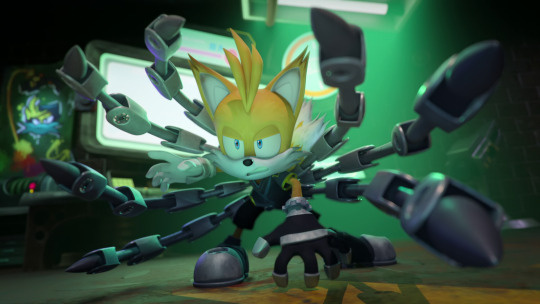
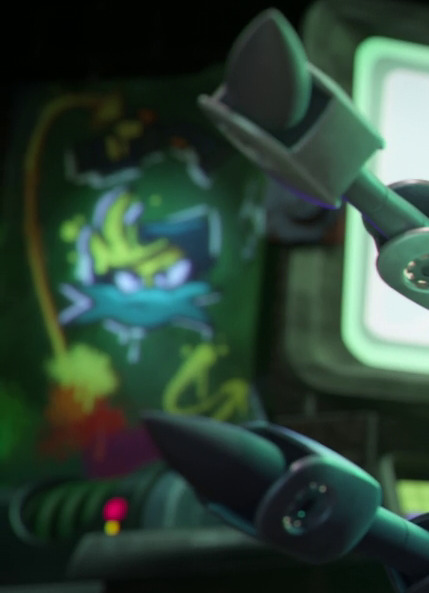
"Oh, but it's just the creators 'prolly drawing him and placing it as a treat" - then how, in-universe, did it appear there? And why is it a drawing of Nine specifically (notice he's shown in his hoodie and off-coloured), alongside a gun (?) and, I assume, some spray tests, just like people test brushes and paints? No one else had access to his base other than Nine himself, and knowing how distrustful he is, he would not let some random street artist barge into his lair and do his portrait on the wall.

What further supports this theory is the fact he has the same drawings in the Grim... which, again, could not be accessed by anyone other than him (by the way, it seems like all the paintings were made on a movable board that Nine must've carried all the way from New Yoke, which still, why would you move THOSE DRAWINGS in particular if you weren't the author that's, I'd even say, proud of them?).
Annndddd let's also not forget the board has a drawing of a gun, like aformentioned - the same one he used to scan Sonic... is that a coincidence? I really, really don't think so.
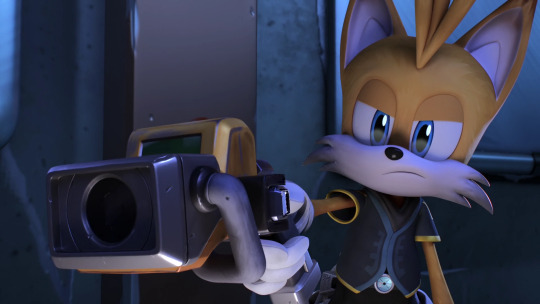
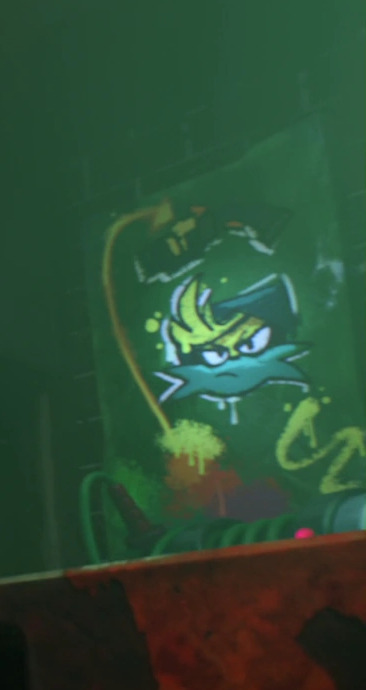
On the ending note(s), can we talk about how he even picks colors and how he portrays himself? Because in the drawing of himself, he seems sharper and more vibrant (f.e.: his fur is phosphorescent lime-yellow, or his muzzle is literally cyan), with a bitching expression ever more amplified by the shadows around his face and a black hoodie, like he even WANTS to be viewed, even in his private home, in interior no one should even see, in a simple spray doodle, as someone dangerous, someone you would never want to cross paths with, someone shady and a little bit of not obvious (that part refers to the absolutely eyesore colours he used; unless Nine is just colorblind and doesn't know how that drawing appears to most people, buut that's more of a big speculation-theory territory that we do not get into in this post).
Second ending, it also further proves that Nine is not really Tails - sure, in the New Yoke universe he does fill the niche of being Miles Prower, same as Mangey does in Boscage Maze and Sails in No Place, but in this equation Nine =/= Tails (and some, like me, would say Nine > Tails, but we call those horrid phases opinions and we keep them under our pillows /lh). They share the basics - being super-intelligent, young foxes skilled in mechanics, inventors bullied for their two tails that overcame hardships due to their determination - but aside from that? The skeleton is identical, but everything else that's bulit upon it is completely different - this is why they aren't really the same person. Tails is a prodigy kid and a hero, accompanied by friends and a team ready to help him, and Nine is an isolated and ostracized anarchist basement dweller driven by anxiety and childhood trauma that also happens to be an artist. And a hacker. And a suprisingly good fighter. And-
And a person with his own identity - imagine stripping away his every single original trait and comparing him to a random kid that's also a "better", more successful version of him that actually won in the end.
A kid that's super great, but can the kid do those amazing grafittis like him? Nah. 1:0 for Nine, losahs' /j
--
tldr; Nine can actually spraypaint and he's good at it, as seen in his New Yoke lab/in Grim - the way he does it kind of tells his personality and thoughts; also further proves Tails and Nine are two different people and that Nine is just occupying Tails' "niche" in his Shatterverse, not directly being him
#sonic prime#sonic prime s3#nine the fox#tails nine#analysis#also he's such an theatre kid lmao#“let's make an Elsa palace in a purple gem wasteland to show my utteerrrr powerrr”#yeah nine this is how you do it
128 notes
·
View notes
Text
I wonder if Disney learned all the wrong lessons from Frozen.
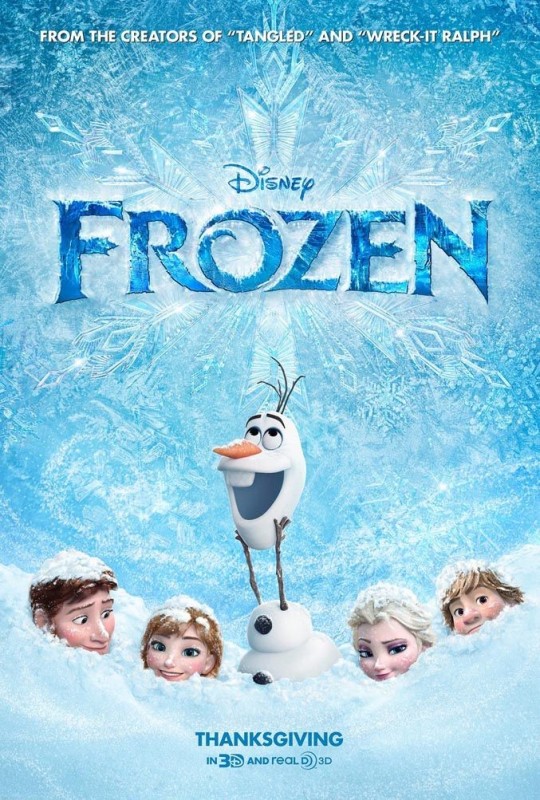
At the time of its release, all Buzzfeed style publications praised the movie for breaking away from the traditional Disney tropes, finally having a relatable heroine in the figure of the adorkable Anna, having a twist villain, and for not focusing on romantic love.
But judging by the reaction of the fandom, people really loved the more traditional Disney tropes, really identified themselves more with the shy, mature and elegant Elsa than with adorkable Anna, didn't care too much about the twist villain, and really found themselves shipping either Anna x Kristoff or Anna x Hans.
With the the negative reception of Disney's Wish, I wonder if the problem with the movie isn't that it stuck too closely with the Disney formula, but that it didn't stick closely enough.
Judging by all the posts I see about Wish, people really wanted a fairy tale romance, a more threatening villain, a more adorable sidekick, and a more traditional princess-like protagonist.
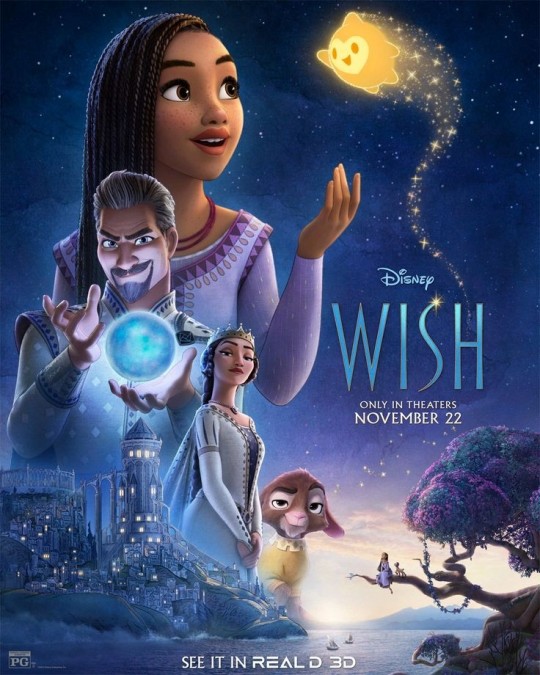
This made me think.
Maybe Buzzfeed was just wrong, and the general audiences hypocritical. Maybe the tropes we all spent years mocking Disney movies for having, like the fairy tale romances, the daydreaming damsels, the beautiful ball gowns, the campy villains, and the fairy tale aesthetic were the things that kept audiences coming back.
And maybe the success of Frozen was that it managed to use these tropes to tell an original story without leaving their fairy tale roots behind.
@ariel-seagull-wings @princesssarisa @mask131 @thelittlehansy @the-blue-fairie @tamisdava2
116 notes
·
View notes
Text
No but the tender "it cannot be a lie if a no one hears" in Elsa's Song, and the mournful echo in Love Run (reprise) makes me want to fucking scream.
I won't listen to your reassurance because the only thing worse than not hearing you is hearing you lie to me. I don't want your sympathy or your pity, I want the truth and I want it to be you but it never can because you WILL forget me. You will. And I would rather die alone pretending you still love me than continue to live whilst you make those same gentle promises to someone else. My last memories of you will not be lies. You won't lie to me, you can't. If I simply cover my ears and shut my eyes, you will remember me. I ask, I sing, I beg, "remember me. Visit my grave, scatter flowers, tell the world who I was. Just don't forget me," but you will. This story can't end any other way, so don't make a promise you can't keep. Let me keep that precious memory of my trust in you until the end, and then you can do as you will. There will be nothing to forgive, because there will be no lies. Not if I can't hear you.
#i didn't mean to reference THATW#but now i cant unsee it#its all about the fear of being forgotten#of oblivion#do you understand#the amazing devil#joey batey#madeleine hyland#song lyrics#tad#amazing devil#music#song analysis#the horror and the wild#love run#elsa's song
91 notes
·
View notes
Text
To Endure the Endless Winter-An Analysis of Kingdom Hearts 3
Arendelle marks a turning point in the narrative of Kingdom Hearts 3, when the looming darkness truly begins to infect Sora’s journey, and when the Second Keyblade War becomes inevitable. The signs were always there of course, from Thebes’s destruction, To more powerful heartless like the Demon Tide showing up in Twilight town, and of course the Organization's more active presence in the Disney worlds. And yet they never got in the way of Sora’s fun. After all, Sora was able to save Buzz from darkness, play games with Rapunzel, and Keep Boo Smiling in spite of the Unversed. But with Arendelle things are different, for the first time Sora’s fairy tale whimsy is challenged by the influence of Xehanort and is forced to endure. For you see Winter is the season where the nights become longer and the darkness grows all the more stronger
This growing sense of strife and danger can be first found in the aesthetics and gameplay of Arendelle. It is a cold harsh world in the mitts of an eternal winter. Every level is covered in snow and ice with Sora even remarking on how cold it is at the beginning, begging Donald to give him a Coat. Much of the world is spent on top of a mountain that the player must climb up. It pushes them to use all their movement abilities throughout the world from using flowmotion to run up the sides of the mountain to using Air Step to grab on the icicles for leverage. The mountain even becomes more dangerous and complicated the closer Sora gets to the top . The path becomes covered in spikes of ice or harsh vortexes of frost that the player must manipulate in order to move forward. Even the very act of having to climb the mountain again ties into this struggle
Enemies are also more dangerous. Large Bodies are replaced with their more powerful brother’s the Helmed Bodies who are far more aggressive, almost always opening with an enraged body attack in order to mow down sora. Parasol Beauties and Satyrs, the most dangerous enemies of previous worlds, now fight side by side. The Rock Troll even shows up at the beginning of the world no longer being just a mid boss but a starting enemies. And let us not forget the new enemies this world has to spare. The Frost serpents are for more than just standard enemies, they are a trial in their own right. When the Frost serpents first appear they take over the game. Unleashing an avalanche of death upon The Half Pint Trio they force the 3 musketeers on to the defense as they have no choice but to flee from the cruelty of nature on Goofy’s makeshift sled of a shield. Control is taken away from the player as they have no choice but follow the rules of the Frost Serpents who act more like dragons as they breathe flames of frostbite down on the heroes in what is perhaps the most difficult challenge in the whole game. Lastly there are the ninja nobodies. The Nobody enemies have always been presented as a more daunting challenge than the heartless. Though their numbers are smaller they make up for it with greater power. Posing abilities akin to that of fantasy heroes, as if to mock Sora and his allies. They give the player a taste of what's to come from the True Organization XIII . And the Ninjas are no different. Mirroring their master the Ninja Nobodies fight with a flurry of cruelty. They move as fast as lighting and hitting as hard as thunder bringing Sora, Donald, and Goofy to their knees with their own DM move, Reverse Thunder
The Most daunting challenge of Arendelle though would have to be the Labyrinth of ice. Created by Larxene this monstrosity exists solely to be a prison of sadism. Unlike Elsa’s castle it does not reflect the beauty of a winter paradise but instead the terrors of the season. It is a cold and lifeless maze with no real exit, designed to trap its victims until they become food for the Forces of Darkness or give in to their own madness. Even bearing the Nobody’s and the Larxene’s symbols to remind its vitamins of who really controls this world. The Only way The Half Pint Trio can escape is if they fight back. They must break the chains of helplessness and destroy the maze from within, melting the walls that keep them trapped and manipulate the very pillars of the maze to create their own freedom.
Things don’t let up in the story either. Throughout their visit to Arendelle Sora constantly tries to befriend Elsa and Anna but he is constantly impeded by Larxene. She does not wish for Sora to connect with Elsa. Instead Larxene wants to test the blooming princess of heart, to see if she is truly worthy of possessing one of the 7 pure lights. So she allows Elsa to descend into loneliness, letting her fear consume her in hopes of seeing the queen fall to darkness. And thus Sora is not allowed to act as the hero. He is constantly kept apart from Elsa, to keep him from showing her the beauty of her world and save her from her own doubts. Even Sora’s time spent with Anna, Kristoff, and Olaff is cut short by the heartless. Through Xehanort’s ever growing will the fairy tale whimsy that defines Sora’s journey begins to melt away
And yet Sora and The player are still able to endure. They overcome every challenge laid throughout their path by Larxene. And it is through these acts of endurance and defiance that both the player and Sora are able to reclaim the joy of this world. Upon conquering Larxene’s cruelty and escaping the Labyrinth The Half Pint Trio is greeted with a beautiful sight, the northern lights that illuminated the chilling winter sky. For the first time they are able to indulge in the wonder of winter. And this is where Sora begins to fall in love with the snow as he learns to play with the snowball. Using them as an instrument of his will, Sora takes the simple and joyous act of creating a giant snowball and uses it against the heartless, one shooting them as he rolls them into his snowball. Creating not only the perfect strategy against Heartless like the Helmed bodies, but a new reward for sora since the bigger the snowball the greater the synthesis item it drops. Even the player gets to join in on the winter fun with the sledding mini game. After the bone chilling chase with the Frost Serpents ends the player is rewarded with a delightful sled ride down the rest of the mountain where they not only get to have fun but are given tons of free HP Orbs and Munney.
Even though Sora’s time spent with Anna, Kristoff, and Olaf is cut short he still manages to make the moment worth it. He connects with Anna learning not only more about Elsa but manages to cement a bond between himself and Anna by relating his experiences with Riku to the relationship of Anna and Elsa. Then of course there is the time spent Fixing Olaf. Helping establish a bond with not only Kristoff and Olaf But allowing Sora to partake in the most beloved of winter traditions, Building a snowman.
Though perhaps the greatest boom Sora receives for his willingness to hold on to his ideals in the face of a looming darkness would be none other than the party member of this world, Marshmallow. Marshmallow started off as another obstacle for Sora to overcome. Born from the guilt and fear forced upon her by Larxene’s actions, Marshmallow represented all Elsa saw herself as, a monster that only pushes people away. And yet not only were the Half Pint Trio able to defeat him with their special brand of slap stick fighting BUT they grew to befriend him. By not giving up on Elsa and keeping faith in her even in her darkest moments they were able to reveal who Marshmallow and by an extension, Elsa truly were. Not monsters that hurt those close to them, but a guardian who protects others. Marshmallow becomes one of Sora’s most powerful allies possessing the raw strength equal to Beast and magical fire power on par with Jack Skeleton as he quietly literally endures the full force of a blizzard in order to forge a path for Sora,Donald, and Goofy.
Larxene acting as Xehanort’s hands works to poison the fairy tale beauty of Arendelle. She isolates Elsa for her own self interest, fills the worlds with heartless and Nobodies to spread fear, mocks Elsa’s powers through the creation of the Ice Labrinth, and most importantly of all She tries all she can to keep sora from making friends with the people of Arendelle. And yet all her attempts at roadblocking Sora fail as he endures the pain and keeps moving forward, spreading Disney joy to Anna And Elsa in spite of her actions. And it’s plain to see why Larxene fails despite being the one with all the power. Larxene and Xehanort by an extent are not willing to accept pain. They are cowards who hide in the back and let others do all the work for them. Xehanort has always manipulated people to get what he wants, makes his allies do all the dirty work while he reaps the rewards. Where As Larxene loves to lord over other people. Using whatever authority she can get her hand on to torment the weak, to make herself feel better without ever having to work on improving. And this unwillingness to bear the hardships of life is reflected in the Heartless and Nobodies they employ.
The ninja nobodies may present themselves as strong but once they begin to lose they panic. Their Desperation Move of Reverse Thunder is not like that of the nobodies Sora fought before. The previous Desperation Moves were a strong act of resolve and defiance as they used all they had to try and strike down Sora whereas the Ninja’s just sliver into themselves and create a bubble of electricity to avoid anymore pain. They’re unwilling to risk it all and fight back, choosing instead to only prolong their fate. The Ice Serpents masquerade as mighty monsters using their wings and chilly breath to present themselves as something kin to the Proud Dragons of Old but once they lose their wings they reveal their true nature. No longer fighting with pride, these frozen wretches start to live up to their namesake of serpents as they slither into the ground, attempting to attack their prey from behind like a coward. For there is no nobility in those that can not stand strong when the going gets tough. And lastly there is the Beast of the Blizzard, Skoll. The Heartless Skoll was spawned from the Darkness of a man named Han. Born the 13th son of a Royal Family, Hans was the runt of the litter. The one who was always picked on and the one without an inheritage. Since birth his life has been met with obstacles but he did not have the resolve to face it. Rather than face the hardships of life like a man he chose to cheat by stealing the two sister's kingdom from them using manipulation and force. And so his pathetic nature was reflected in his Heartless. Just like the Ninjas and Ice Sepernats beforehand Skoll gives off the impression of strength through his large body, great speed, and sharp claws. And just like the other 2 monsters from before Skoll’s strength is revealed to be nothing more than an illusion. Throughout the fight Skoll summons weaker pups, depending on others to fight for him while spends most of the battle running away, acting more like a frightened dog than a hardened hunter. Even Skoll’s design reflects his deception. Skoll does not have the complete body of a wolf instead his is nothing more than a head, a pair of claws and a tail. He has all it takes to cast the shadow of a wolf but nothing more. Most importantly of all there is Skoll’s Desperation Move, Dark Sun. When Skoll uses Dark Sun he chooses to give up. He no longer wishes to fight for himself, to pursue life in the face of pain. No he just wishes to end it all, Transforming his very body into a pale imitation of the sun. He becomes a celestial body of darkness raining down his tears of Dark Firaga and Pups upon the battlefield, buying time until he can unless a catastrophic collision, killing everyone. Of course such a cowardly attack like that would never work against those who choose to endure. Marshmallow puts his life on the line using just his bare hands to keep the Dark Sun from crashing down while Sora pushes past his limits to break it.
Despite all of Sora’s victories over Larxene in Arrendale the world ultimately ends on a bittersweet note. Anna, Elsa, and The Kingdom are saved but said safety is only temporary as Sora now knows that they are still a target for the Thirteen Seekers of Darkness. If he wishes to protect their happily ever after then Sora has no choice but to face Xehanort himself. And worst of all Sora is forced to accept a heartbreaking truth, The Keyblade war is unavoidable, The True Organization is on the verge of getting their final member and he can not stop it. For this battle is the will of destiny. And it is fitting that a world about enduring would end on such a note because truthfully nobody ever has to stop enduring hardships. The universe will always have more to throw at you, life is never going to get easy, but that doesn't mean you should give up. You need to hold on to your ideals no matter what and stand up to cruelty. And that is why Sora accepts his fate and chooses to fight Master Xehanort.
#kingdom hearts#kh#sora#disney#kh sora#kh analysis#kh essay#kingdom hearts 3#my essays#priph essay#kh riku#kh3 spoilers#disney frozen#Pixar Boo#disney elsa#disney anna#kristoff#disney olaf#master xehanort#larxene#kh larxene#kh xehanort#organization xiii#organization 13#13 Seekers of Darkness#heartless#kh nobodies#Disney Hans#Frozen marshmallow#Keybalde War
14 notes
·
View notes
Text
Another sighting of Hans's ship at Frozen Kingdom, Fantasy Springs!⛵

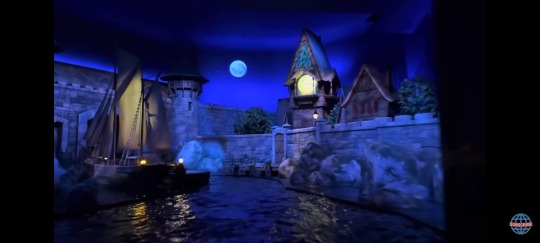
The ship is a part of the brand new boat ride "Anna and Elsa's Frozen Journey" at Tokyo DisneySea, replicating a scene from Love is an open door. The ride also features some new animations of young Anna and Elsa and well as Elsa and Hans!
Video source
You can find other appearances of Hans's ship in our previous post.
#frozen#frozen 2#arendelle archives#frozen analysis#frozen fandom#disney frozen#arendelle#frozen kingdom#fantasy springs#tokyo disneysea#hans westergaard#hans of the southern isles#queen elsa#princess anna#frozen lore
34 notes
·
View notes
Text
The 13th post: More than a Disney Prince
“Hans is a prince. He is a Disney Prince, but he’s more than a Disney Prince. He is many things. And there are a lots of secrets and twists and turns that we take with Hans.” "A lot of the scenes I recorded did not end up in the movie" Santino Fontana on Hans.
From Admiral Westergaard to Prince Hans of the Southern Isles
As you will already know, Frozen is an adaptation from the tale “The Snow Queen” by danish author Hans Christian Andersen. Disney had been trying to adapt “The Snow Queen” for decades. Different ideas were developed and a lot of changes were made in the process (you have a really interesting post about Frozen’s development by @greatqueenanna here).
We know that at some point, when Elsa still was a villain, the idea for Hans’ character was a nameless “Admiral Westergaard”, who was Anna’s love interest.
Evil Elsa deleted scene
Elsa was then changed, from a villain to a villain who had a redemption thanks to Anna, while Admiral Westergaard became a surprise villain.
Fast-forward to the final act: Elsa creates an army of snow monsters to attack our heroes while Kristoff has “a Han Solo moment” and comes to help Anna. To halt Elsa’s attacking army, the two-faced Prince Hans triggers a massive avalanche — not caring that the avalanche also puts Anna, Elsa and all of Arendelle in jeopardy. Anna realizes Elsa is their only hope, so she convinces her to use her powers to save the kingdom (...) Elsa’s heart is then unfrozen allowing her to love again.
At some point, Admiral Westergaard was changed to Prince Hans of the Southern Isles. This is a strange change for a villanous character if you ask me: they not only made him a Disney prince by birth, but also gave him the first name of the author of the original tale. Besides, keeping in mind that the names of the main characters in Frozen are meant to be a Hans Christian Andersen reference (Hans Kristoff Anna Sven), prince Hans would somehow be the most important, because he’s the one who was given the author’s first name. Makes sense, doesn't it?
Oh, but maybe it's just a coincidence.
Besides this, there is the fact that the kingdom’s name, Arendelle, is based in the norwegian town of Arendal. The isles located south of Arendal are, in real life, Denmark. And Hans Christian Andersen was danish. So they gave prince Hans not only the name but also the nationality of the author.
Also a coincidence?
Disney gave us a huge, very important clue with the Frozen Fever map.

This picture was originally posted by @wrath-of-zirro. A lot to analyze here.
On the top left corner there is a map of real Arendall with Denmark on the south; and the Frozen Fever map on the right. It is clear "The Southern Isles" are the danish isles of Fyn and its surroundings.
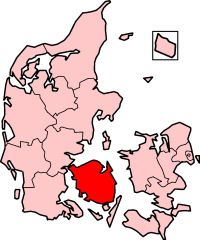
Map of real life Denmark with Fyn (Funen) in red from Wikipedia. Compare to The Southern Isles in the Frozen Fever map.
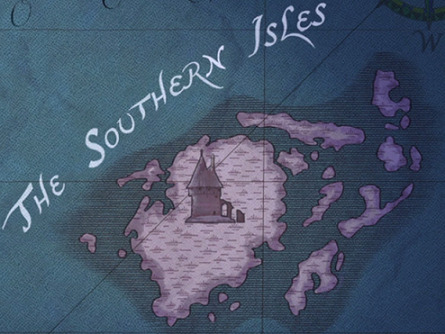
Hans Christian Andersen was born in Odense, capital city of Fyn.
In the bottom of the picture we see the Egeskov Castle in Fyn, whose tower reminds of the one we see in The Southern Isles in the Frozen Fever map. It looks like it the castle was still under construction in the Frozen Fever map (there are 13 princes, so they need a huge castle I guess!). It's quite hard to me to think all of this is just a coincidence.
But that is not the only Andersen reference. Hans having twelve older brothers reminds of Andersen's tale The Wild Swans. That tale is about a princess who has eleven older brothers. The princess is named Eliza, which reminds of Elsa and, not unlike her, she is taken for a witch and is almost killed for that reason.
It is also known that Disney planned to make a movie about the danish author's life which started developing in the 1940s (the same time period in which they started trying to adapt The Snow Queen).
That project was later abandoned. Nevertheless, Disney has adapted many of the danish author's tales.
So... could it be that when Frozen was finally made, the creators decided to pay homage to the danish author by making him a Disney Prince?
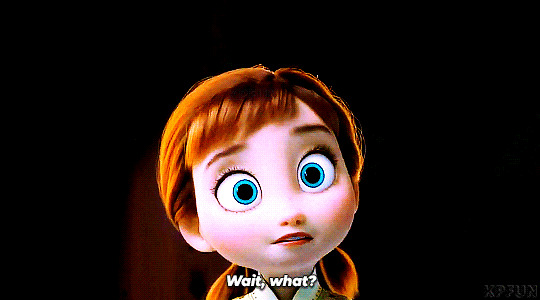
But wait... there is more.
Thanks to @thelittlehansy I knew Hans Christian Andersen himself appeared as an animated character in an episode of The Little Mermaid animated series, called "Metal Fish". So, if Disney already had an animated character design for H.C. Andersen, and Prince Hans was a tribute to the author, it would make sense they would look alike, wouldn't it? They just had to redesign the character to make him look young, regal and handsome. Let's have a look at how did the animated version of the danish author look like. I found the episode in swedish language on Youtube:
Part 1
Part 2


They look pretty similar to me. Ginger, big nose, large chin, with sideburns, wears a vest and, in the last scene, a tailcoat. Even the fringe is similar. If you still think all of this is a coincidence I have to disagree. As the Duke would say: The can be no doubt now.
Frozen Fandom: But that's not posible! Making the author a villain, not very important for the story, and the center of silly jokes?! That would be so disrespectful!
Well, I have spent two years trying to prove Frozen makes perfect sense withouth Hans being a bad guy. Santino Fontana said a lot of the scenes he recorded weren't finally included in the movie, so it's safe to think we miss a lot of information about the character. The movie is not badly written; it's too well written in fact: the plotholes are part of the plot.
Frozen Fandom: But Hans is the villain!! He plotted a whole plan to take over the kingdom, took advantage of Anna's vulnerability, leave her to die when she needed him the most and let's not forget almost decapitate Elsa after lying to her about her sister's death.
*Sighs in frustration* All you can accuse Hans of is being a jerk to a dying Anna, being in a very stressfull, life-or-death situation. But let's deny these accusations one by one.
Lying to Elsa about Anna's death: Technically, he wasn't lying, as Anna was dying because of ice magic and Hans though (because of Anna's own words!) Elsa willingly attacked her.
Almost decapitated Elsa: Already explained in the 11th post of this analysis.
Leave Anna to die: Hans was sure there was nothing he - or anyone else - could make to save Anna, and let's not forget the overall situation: people in the kingdom was in inminent risk of dying because of the winter (remember the Duke's words: if we don't "do something" ( = kill Elsa) soon, we all will freeze to death), and he was really shocked (see 9th post of this analysis) to know Elsa had attacked Anna.


Plotted a whole plan to take over the kingdom: The only evidence for this is his own "villain monologue", which I don't think we should take seriously for reasons already explained in the 9th and 12th posts. Telling Anna he wanted to marry her and then arrange "a little accident" of Elsa is more him being a jerk than confessing an evil scheme.
Took advantage of Anna's vulnerability: I have to disagree. I think he manipulated her a bit, but not all of the time. If we look at their "date" from an objective point of view, we realize that for the most part he was just being friendly. Dancing, taking a walk, eating something is not something particularly romantic.
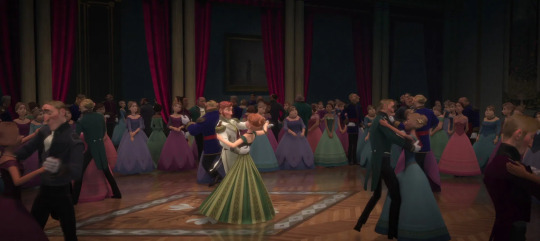
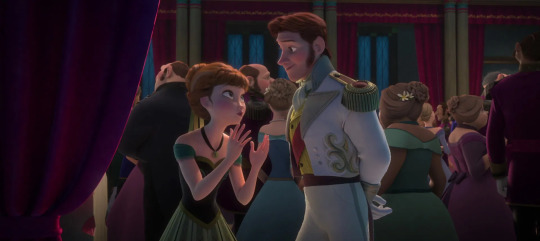
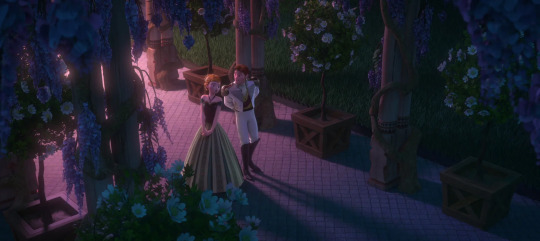
There were not ardent love expressions, he didn't even tell Anna he loved her. Can we really say he "seduced" her? The shoulder bump is romantic? It's more a friendly gesture, that is coded later in the saga as a "sibling thing".
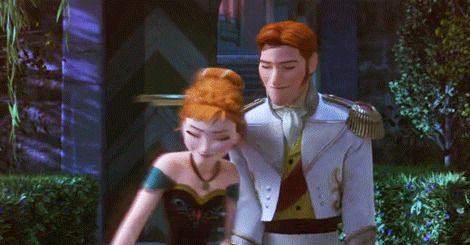
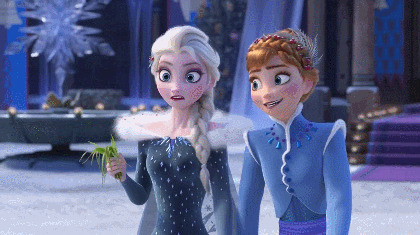
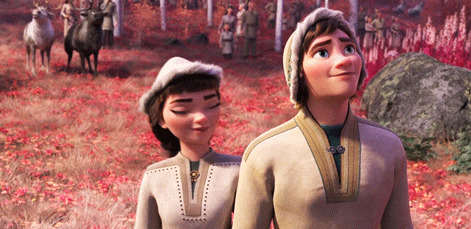
We are led to see the scene in a subjective way, through Anna's eyes. But if we rewacht the scene from an objective point of view, all we see is a friendly interaction.Things don't get really "romantic" until "Love is an Open Door". And let's not forget it's Anna who begins it and this is Hans' first reaction:

Then he basically plays along with her, and at the end of the song - when he proposes to her - that's where the manipulation begins.
Another reason against Hans being a villain would be his facial expressions. He only has facial expressions that could be labeled as villainous in a few scenes (already explained in previous posts). I find it very telling that when he sentences Elsa to death, creators chose to give us a close-up of his face expressing sadness - when a smirk would be more fitting, since this happens after the betrayal scene. It's like they wanted to tell the audience: "No, Hans is not happy to sentence Elsa to death; he is devastated".


Frozen Fandom: He`s faking to the Duke and the dignataries.
It could be, but it's unusual for Disney characters to fake to the audience. Gaston makes villanous expressions since he first appears, so the audience can easily identify him as a villain... but everyone in the town think he's a great guy!
And Mother Gothel... think how interesting would it be if the audience wasn't given the backstory at the beginning of Tangled. But still in that case, we would be able to analize her expressions and realize they are different from those of a worried parent.


Frozen Fandom: well, so who do you think is the villain then?
Simple: there is no real villain in Frozen. But there are two fake villains. This pair.
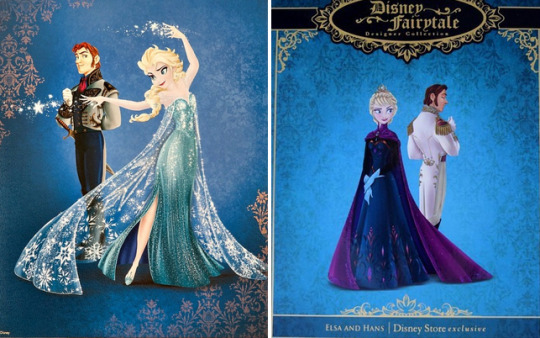
Before we continue we have to make the following question: who is this Elsa?
But was she the cursed princess to be saved, or the wicked witch to be vanquished? And what was his role in this story? (A particular understanding, by @fasadi)
Elsa: A witch in distress
While most of the audience identifies Elsa as a princess, making Frozen a "two princesses movie", this is only half truth. Anna is "the princess" and real protagonist in Frozen, while her sister shares some traits with other kind of classic Disney characters. Let's see: Elsa...
Is older than the princess
Has magical powers
Lives isolated
Has a position of power (she's the princess heir and becomes the Queen)
Wears heavy make up
Wears purple clothes (her coronation cape) and uses purple eyeshadow
Curses the princess and the kingdom
Her actions have a huge impact on the plot
Has a great (villain) song
Is (almost) killed by the prince
The 13th Disney princess shares these characteristics with these ladies:

From my point of view, the Evil Queen from Snow White is the one that has had the biggest influence in Elsa's look. I found the following description of the Evil Queen on the Disney fandom wiki very fitting for Elsa:
"From the outside, the Queen appears to be calm, regal, and sophisticated, but in reality, this collected and stately facade hides an extremely sadistic, hateful, cold and sinister person" (Elsa's facade is similar and also hides her real self) "The Queen is an icily beautiful woman with a serene, unfeeling face and a slender figure. She has pale skin, red lips, green eyes, and seemingly penciled-on eyebrows"


They both wear a long cape with a pendant. You can't really blame the Duke for thinking Elsa was "a wicked witch conspiring to destroy us all", can you? After all, this is a fairy tale. There has to be a witch!
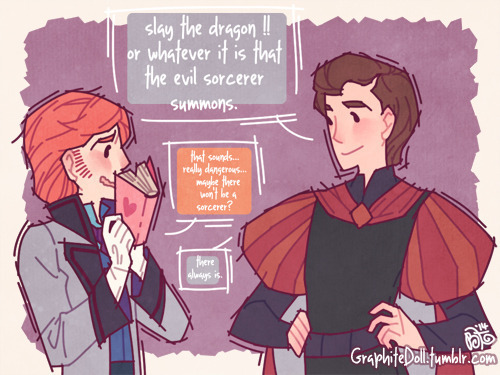
(Full comic here. A very fun comic showing Hans has all the traits of a classic Disney Prince. I'd love to see something similar with Elsa as a classic Disney Witch!).
At the end of the day, Elsa mortally attacked her sister and almost killed her whole kingdom because she had a massive anxiety attack. But even if she is, technically, a Disney witch and the villain of the movie (in the sense her actions are those of a villain) Elsa is not evil. Her thoughts, feelings and motivations are very different of those of a villain. She can't control her powers and feels unable to cope with the problems she has created, so her response is to run away.
This learned helplessness makes her another classic character: the damsel in distress. Elsa has to be saved from those who want to kill her to end the eternal winter and save the winter. She is first saved by Hans, who risked his own life entering the Ice Castle to save her from the Weselton guards and was able to stop her with a sentence that basically meant "I trust you" (whole analysis in the 7th post) and later saved by Anna. And, just like Hans saved Elsa from killing two men, Anna saved Hans from killing Elsa.
But, just because the audience "knows" Elsa they fail to identify her as the witch of this tale. They fail to understand that the Duke's reaction and prejudices against Elsa were, in fact, quite logic and understable. They fail to understand that (almost) everyone in Arendelle feared Elsa and wanted her dead, so the curse disappeared. The audience has all the information they need to realize Elsa meant no harm but... do the audience has all the information they need to understand Hans' character, and his sudden change at the end of the movie? I'm pretty sure we miss essential information.
Remember my interpretation of the gloves parallel in the analysis of the betrayal scene? One glove off = fake villain reveal. Now look at the Hans and Elsa dolls. "Hero and villain" series, and there are TWO sets of dolls. The first one: Elsa as the Snow Queen (hero), Hans in his fake villain reveal clothes (villain). The second one: they are in their coronation clothes, Elsa as a Queen who is secretly a witch (villain), Hans as the perfect Disney prince (hero). And the looks of complicity are very obvious.
And if Prince Hans' inspiration was the danish author himself, is there some real life woman behind Elsa?
The answer is Yes.
Hans Christian Andersen's inspiration for the Snow Queen was the most important of his (long) list of imposible loves.
Jenny Lind
Johanna Maria "Jenny" Lind (6 October 1820 – 2 November 1887) was a Swedish opera singer, often called the "Swedish Nightingale". One of the most highly regarded singers of the 19th century, she performed in soprano roles in opera in Sweden and across Europe, and undertook an extraordinarily popular concert tour of the United States beginning in 1850. She was a member of the Royal Swedish Academy of Music from 1840.

Yes, I know she doesn't look like Elsa. But still, she was the inspiration for the Snow Queen, and Elsa is inspired on the Snow Queen, so... she somehow "is" Elsa.
From Wikipedia:
She toured Denmark where, in 1843, Hans Christian Andersen met and fell in love with her. Although the two became good friends, she did not reciprocate his romantic feelings. She is believed to have inspired three of his fairy tales: "Beneath the Pillar", "The Angel" and "The Nightingale".[4] He wrote, "No book or personality whatever has exerted a more ennobling influence on me, as a poet, than Jenny Lind. For me she opened the sanctuary of art."[4] The biographer Carol Rosen believes that after Lind rejected Andersen as a suitor, he portrayed her as The Snow Queen with a heart of ice.
One of his stories, "The Nightingale", was written as an expression of his passion for Jenny Lind and became the inspiration for her nickname, the "Swedish Nightingale".[46] Andersen was often shy around women and had extreme difficulty in proposing to Lind. When Lind was boarding a train to go to an opera concert, Andersen gave Lind a letter of proposal. Her feelings towards him were not the same; she saw him as a brother, writing to him in 1844: "farewell ... God bless and protect my brother is the sincere wish of his affectionate sister, Jenny".[47] It is suggested that Andersen expressed his disappointment by portraying Lind as the eponymous anti-heroine of his Snow Queen.[48]
So, to sum up this very long post:
Hans and Elsa
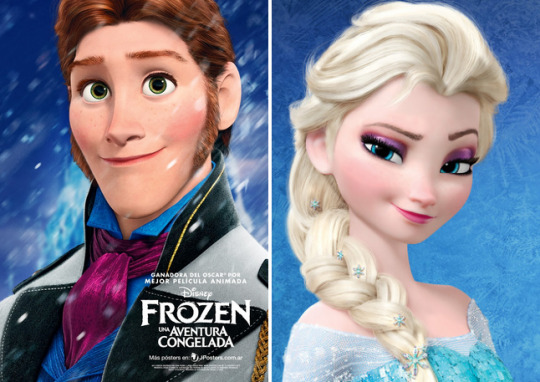
Who people think they are

Who they really are
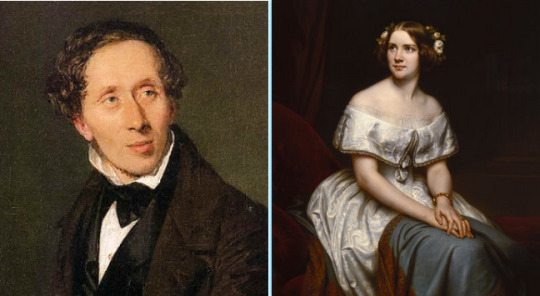
Conclusion
So... if I'm on the right track, and Disney created Prince Hans' character as a tribute to Hans Christian Andersen, wouldn't it make sense they planned to give him the happy ending he did not have in real life?
Time to analyze the Helsa hints...but that will be in a next post.
First post of these series here.
#frozen#disney#frozen analysis#hans analysis#hans#prince hans#hans of the southern isles#prince hans of the southern isles#hans frozen#let's redeem hans#my theories#who is this hans#disneyfilms#santino fontana#frozensource#elsa#queen elsa#elsa frozen#elsa disney#who is this elsa#elsa is a disney witch#frozen fever#the southern isles#fyn#fyn denmark#denmark#funen#funen denmark#egeskov castle#frozen disney
104 notes
·
View notes
Text
Queerwolf By Night: Queercoding, Media Literacy, and Werewolf By Night (part 2)
Welcome back to Media Studies And Writing Hacks With Kat! Part 1 is here if you missed it. We discussed queercoding: what it is, how it works, why it exists, and how it plays into the 1930s and 40s horror movies Werewolf By Night likes to reference.
Once again, the thesis I'm arguing here is that there is queercoding in WBN, and that it should be part of the discussion of the special (which I'm calling a movie or film because I think "special presentation" is dumb and this is my essay.) I am NOT arguing that WBN is explicitly queer, or that inferring heterosexuality where queercoding exists is morally wrong or even textually inaccurate.
TL;DR: you can totally still ship Jack and Elsa, I just wanna point at some metaphorical rainbows and say, "Look! Rainbows! Aren't they neat?" I personally think the queercoding adds a layer of richness to the story. I hope you get something out of it, too.
And now, allow me to introduce our starting point, the wolfman of the hour, everyone's beloved blorbo and queercoded icon: Jack Russell.

Look at this adorable protagonist, this absolute chewtoy of a human being.
He's queercoded as fuck. Not as much as Ted, but we will GET to Ted.
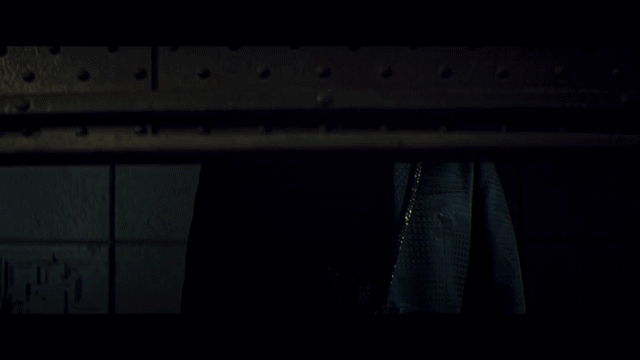
Let's begin with Jack's introduction, where he is literally revealed as the narrator speaks the phrase "the monster who finds himself among them". We join Jack as he enters an unknowingly hostile space, a building full of people who would literally mount his head on the wall if they knew who and what he really was. Jack's introduction to this world is a series of Bayeux-style tapestries showing, among other things, the gory slaughter of his kind. We see him react with a mixture of shock, queasiness, and tamped-down anxiety, which marks him as an outsider. It seems unlikely that the other hunters would be grossed out by the sight of a depiction of their literal jobs.
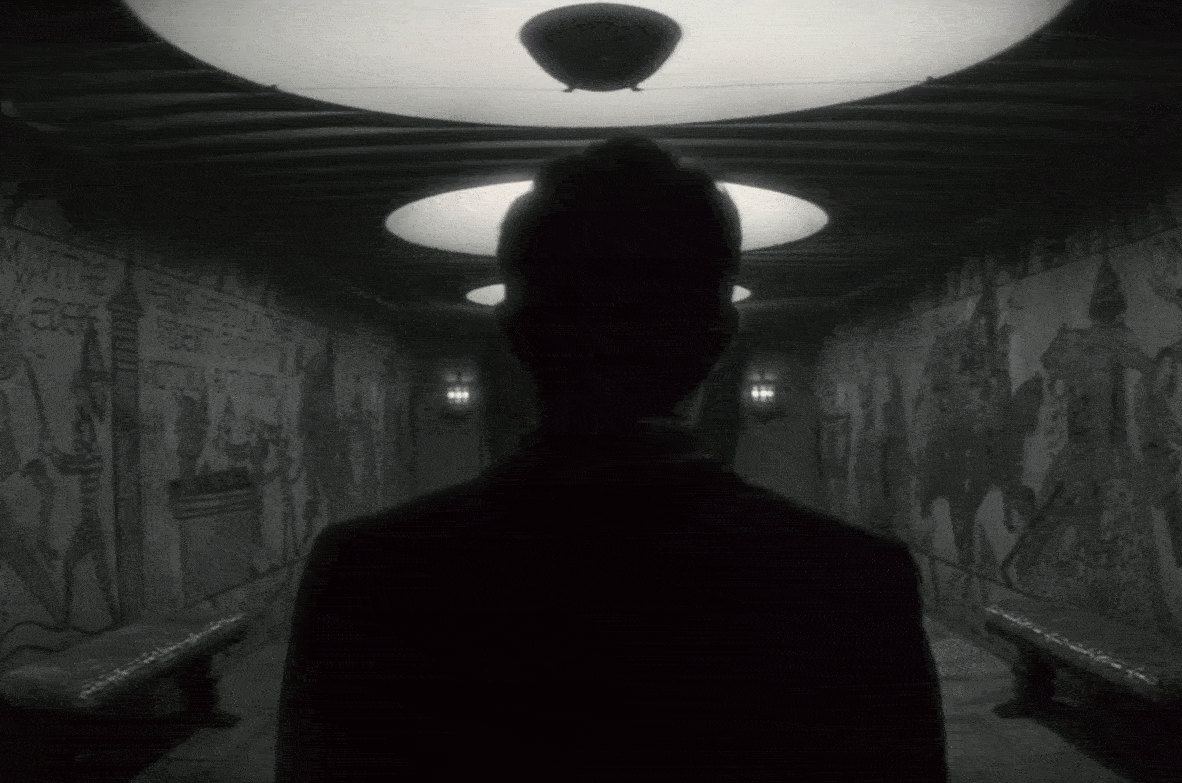
Now, outsider status alone isn't necessarily queercoding, but it often is, especially in monster movies. Jack's reaction is not dissimilar to that of a closeted person entering a homophobic church for some kind of socially expected ritual--and, indeed, Jack has come for a funeral.
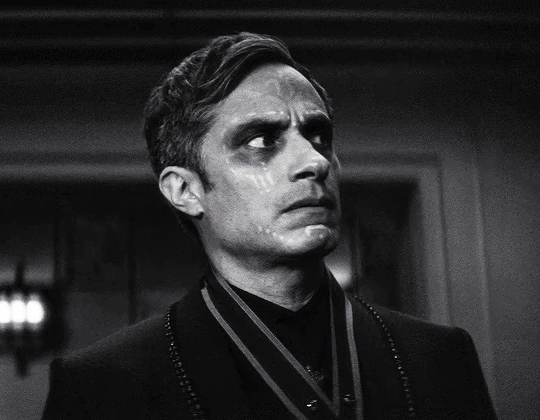
Look at that nervous glance as he walks into the room. He's not comfortable here. He knows he doesn't fit in.
This is a good time to mention Jack's outfit and the way it intersects with what we see of hunter culture. From the leather to the weapons to the heads on the wall, the aesthetic of hunter culture in WBN is hypermasculine, almost to the point of parody. The obsession with imagery of violence and death (the paintings on the walls, the corpse animatronic, the skull bowl) and the hostility to anything perceived as feminine is marked.
Wait. Hostility to anything feminine? Yes, I said that.
There are three characters who are played by female actors: Elsa, Verussa, and ... look, the hunters HAVE names, but I'm just gonna call them Scottish Guy, Asian Guy, Black Guy, and David Bowie. So David Bowie is an adrogynous character played by a female actor who acts as our third not-exactly-a-male character, and it's interesting to me that they're taken more seriously by the other hunters than Elsa is. Elsa, by contrast, is treated with contempt by the other hunters--and the contempt is very specifically gendered. Scottish Guy calls her "lassie" when he threatens her, and Asian Guy says, "Where's the lovely lady's medallion?" with a noticeable leer. They don't take her seriously, not even after Verussa announces she's welcome to participate--and they only brighten up when Verussa reminds them that they're allowed to kill Elsa if they can. That's the response to the only unambiguously female hunter.
Now, you may point out that Verussa doesn't get nearly as much shit from the hunters, but Verussa is explicitly presenting herself as the servant (and sexual partner) of a man. She's also not competing with them for the Bloodstone, nor trying to inherit, even though presumably she has at least as good a claim as Elsa does. She's not trying to enter the hypermasculine realm of hunting, but Elsa is in it, and so Elsa is despised and Verussa is tolerated.
And then there's Jack.
Okay, time for Baby's First Queercoding Element: gender nonconformity. In general, feminine male characters and masculine female characters (something explicitly forbidden by the Hays Code, by the way) are coded as queer. A lot of gay male stereotypes are men doing "womanly" things, like cooking and wearing dresses and having sex with men. The same goes for lesbian stereotypes like short haircuts, manual labor, and having sex with women. Now, obviously ACTUAL queer expression is infinitely more complex, but stereotypes don't do infinite complexity.
So. Is Jack feminine?
Well, he's wearing a gentleman's suit, but by the standards of hunter hypermasculinity, yeah, he's pretty girly. For one thing, he's wearing that suit in a room full of people in combat gear. For another, the suit itself is full of fussy details that mark him as a man who cares a great deal about his appearance, another stereotypically feminine trait. The suit is green, a barely acceptable color in menswear, and it has glittery details like the trim on his lapels. The spinal-column tie is metal as fuck, but it's also a silk tie. He's doing the death-and-gore theme, but making it high fashion. He's even wearing makeup. Granted, it's Día de los Muertos makeup, but it's still pigment on his face for aesthetic purposes. He's also the only hunter who acknowledges, in dialogue, that he has non-white, non-USAmerican heritage--"It's to honor my ancestors." He marks himself (literally) as visibly foreign, even though denigrating foreign masculinity is a big part of American hypermasculinity. He also tries to smile at and befriend every hunter who glares at him--another stereotypically feminine trait that leads to his conversation with Scottish Guy.
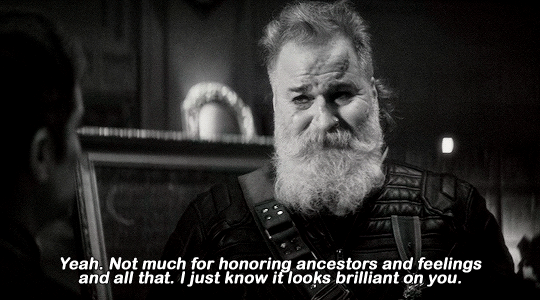
Speaking of, that conversation is gay as hell. It's practically flirting, especially the part where Scottish Guy compliments Jack's makeup and then tearfully admits that hunting and living all by himself "gets lonely". And Jack makes this amazing face:
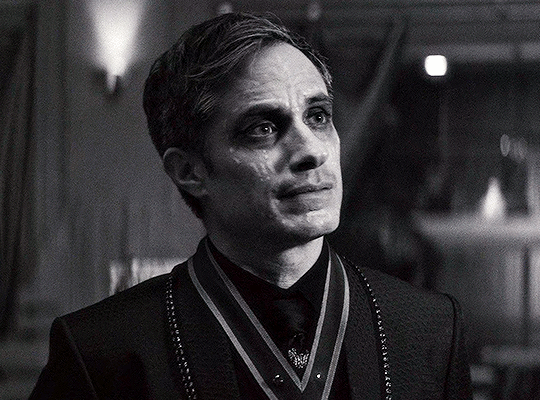
Now, this is me inferring again, but I read this face as a combination of "Aww, that's sweet of you" and "Loneliness caused by hypermasculine self-isolation? I literally have no idea what that's like, but it sounds bad, bro." Perhaps with a soupçon of "Get me out of this conversation aaaaaaa."
So the scene rolls on, and Jack continues to be Bad At Toxic Hypermasculinity. When his top kill count is mentioned, he shrugs it off rather than taking a little bow like the others do. He actually chuckles at Ulysses' joke. He seems mildly interested in Elsa rather than hostile, and amused by her snark rather than threatened by it. He shows fear and worry when he learns Ted is in peril and in pain. The guy really wears his heart on his impeccably tailored sleeve. Notably, none of these traits are bad, per se--they're just more likely to be assigned to feminine characters, and they're given to Jack.
It's important to note the impact of perspective here. Jack is our POV character. If there were to be a hunters' version of this story, Jack would be a sneaky, cowardly, vaguely effeminate villain and Elsa a traitor (or possibly a dimwitted victim seduced by Jack's charms). All of Jack's queercoding would make him a GREAT queercoded villain; it's just that here, he's the protagonist, and a deeply sympathetic one at that, so we miss some of his "unmanly" traits.
All right, let's fast-forward to the maze. We see Jack being clueless and awkward about the drawing of lots, we see some sneaking around, and then we see his first hostile encounter with Elsa, and we get this great exchange:
Jack: I suggest we just pass each other by.
Elsa: ... What?!
Jack, visibly pained by the awkwardness: I suggest we just ... pass each other by.
Jack is uncomfortable with violence. He actively avoids it, talking his way out of trouble when he can and running when he can't. Even Elsa points out how strange he is compared to other hunters, specifically because he avoids violence. He doesn't kill or even hurt anyone in his human form. He doesn't even know how his explosive works--to the point where he asks a woman if SHE knows how to work it.
I'm not saying violence is an inherently masculine trait, but the association of masculinity with a capacity for (and comfort with) violence runs deep in Western culture in general and American culture in particular. It's a huge thing in Mexican culture as well, and yet Jack is actively choosing not to participate in it. He's denying a core part of what would otherwise be his traditional gender role. He later tells Elsa that any "hunting" he does is done by "a part of me that is not me"--a part of himself that he doesn't see as himself. In his eyes, violence is not merely scary or distasteful; it's not part of him at all.
(Compare this to all the ass-kicking Elsa does.)
And then we get to Ted. Buckle up, guys.
Technically, our first introduction to Ted is a distant roar and some screaming, but the moment where we meet him is this:

A jumpscare, followed by a cuddle.

Once again, Jack wears his heart on his sleeve, but more importantly, let me draw your attention to the juxtaposition of Ted's scary grab and Jack's excited snuggling. This relationship is introduced as something scary before being revealed as something sweet--and "scary" is a good description of the portrayal of queercoded couples (who are, remember, usually villains) in classic cinema. All the cinematic language around Ted right up until the grab is telling us to be afraid of him--and then our cinnamon roll of a protagonist starts petting him and greeting him and asking if he's okay. Ted is monstrous and inhuman ... right up until we see him receive affection from another man.
We don't get clear details of Jack's relationship with Ted, but we know that it's a big deal to them--after all, Jack is risking his own life to save the big guy. Jack also describes Ted as "family" and, with a fond eyeroll, a "pain in the ass". Jack implies that he no longer has contact with his family of origin, a common experience for many queer people who are shunned for leaving the closet, but Ted slots neatly into the category of found family. Ted is also, notably, the only close relationship Jack is seen to have, just as Jack is the only close connection Ted is seen to have. The two are physically affectionate (again, cuddling) and emotionally vulnerable in their conversations.
And Elsa, the outsider to their relationship, finds the whole thing bizarre, right down to Ted's name.
Speaking of Elsa, let's talk about Jack's behavior in the crypt and the cage.
In the crypt, Jack displays compassion for someone who has largely been hostile to him (he REALLY wants to fix Elsa's leg), absolute delight when he receives the tiniest signal that she might be sympathetic to him ("It's not in your DNA, then?") and remarkable emotional intelligence (see his speech about families). He also, notably, doesn't hit on Elsa or indicate any sexual interest in her.
He also makes this terrific face when he's handed a skull:
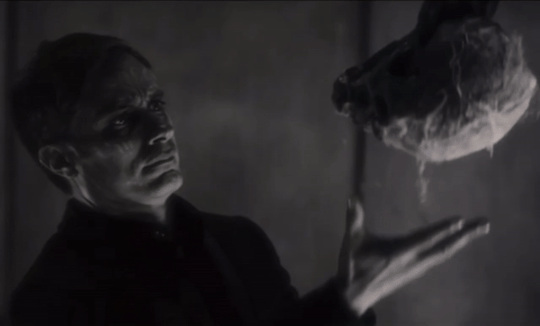
Oh, yeah, that's a big, scary hunter there.
Now, the cage. Jack's response to being put in the cage (and stripped of his jacket, interestingly--little bit of dehumanization there, perhaps) is recognition, followed by attempts at reassuring Elsa, followed by panic. He's arguably more upset than Elsa is, and Elsa thinks she's about to be torn to shreds.
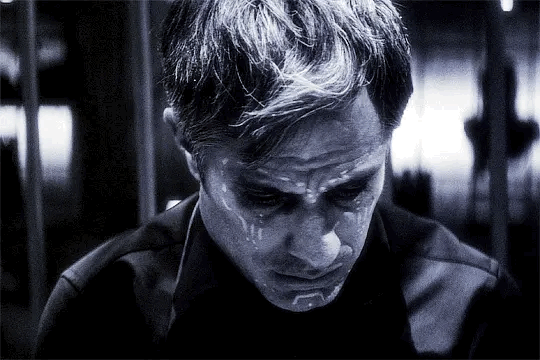
At two points in this story, Jack Russell finds himself trapped in a small space with a beautiful woman and more or less immediately freaks out. It's not the most heterosexual pattern. In fact, it's got strong thematic overtones of queer men being forced into straight relationships by their families, their work, or their society. In a culture that entwines sex and violence, the fact that he's delighted to be grabbed by a male swamp monster but begs for death rather than symbolically do a sex with a woman is noteworthy.
"Symbolically do a sex"? Yeah, the only times the film frames Elsa as anything like a sexual object are the transformation sequence, which is a visual callback to classic sexualized scream queens of yore with her literally in Jack's shadow, and the face-touching scene, where Jack straddles her, their faces almost touch, and then he flees and she sits up with her hair mussed in a dreamy, almost post-orgasmic way.
Michael Giacchino doesn't eroticize violence MUCH, but he's fairly classy about it when he does.
"But wait!" I hear you saying. "What about the sniffing scene? Isn't that eroticized? And it's between Jack and Elsa! Checkmate, liberals!"
First of all, how dare you call me a liberal when my preferred political descriptor is "chaotic good". And second of all ... well, you're HALF right. It IS eroticized...but not because of anything Laura Donnelly or Gael Garcia Bernal is directly doing.
Go watch Elsa's body language during the scene. It's awkward as fuck. She's curled in a ball, knees and elbows out, letting Jack pull on her arm and sniff her hair but not really participating. There's no indication that she wants to be doing this, or even knows what "this" is.
Gael is making a little more of an erotic show about it; in fact, the intensity of his sniffing would probably be an indicator of sexual desire--if he weren't CRYING WHILE HE DOES IT. That's why his voice breaks on "Once."
These are both excellent actors, making very intentional choices with their voices and bodies. They're playing the scene as something that COULD be sexy IF THEY WEREN'T BEING FORCED TO DO IT.
Seriously. There's enough fanfic now that we've all read Jack giving Elsa a leisurely, consensual sniff. You can't tell me Gael and Laura couldn't have made that happen. This is not sexy sniffing. This is angst sniffing. It's just angst sniffing between two beautiful, sympathetic characters who genuinely don't want to hurt each other. It could have been acted and shot in a much sexier way, but it wasn't.
It's also worth noting one last category of queercoding that WBN plays with a lot: dehumanization. A lot of those classic movies played their queercoded characters as specifically less than human, visually aligning them with disliked animals like rats or wolves and often making them literally less human as the story progressed. Even after the Hays Code, monstrous and inhuman queers became a staple of horror movies, especially in the 1980s and 90s as the AIDS crisis convinced a lot of conservative America that LGBTQ people were literal plague rats. There were proposals to tattoo HIV-positive people to identify them, to round them up into camps, to shut HIV-positive kids out of schools because those kids were implicitly queer and therefore not deserving of human rights like an education.
WBN, with its werewolf POV, pushes back on this trope in some specific ways. Jack's line about being "still a human" is an obvious one, as well as his explanation of "systems" to keep other people safe. (It was common during the AIDS crisis for queer people to be fired from their jobs if they were outed because they were considered an AIDS risk to their coworkers--even if they were, say, an office worker who didn't have any contact with other people's bodily fluids. There were conspiracy theories about AIDS spreading through shared soda cans. Those paper seat protectors in public bathrooms came about because of fears that AIDS could spread via toilet seats. So imagine a gay man trying to explain that he's not a threat to his officemates, and you'll see the parallels to Jack trying to reassure Elsa.)
Most notable, however, is how Elsa survives the wolf. She's safe because she maintains eye contact (implicitly acknowledging her and Jack's shared humanity--she literally refuses to stop seeing him) and because he remembers her scent (she becomes a part of his world as he becomes part of hers). Elsa is rewarded, both with her life and with her inheritance, for treating Jack and Ted like human beings when the world around her regards them as abominations.
Elsa is an ally. She's ally-coded. She can also be read as a love interest for Jack, but she consistently acts in support of his relationship with Ted as well.
In Part 3, we're going to talk about the crowning moment of queercoding in WBN. That's right--it's time to learn about coffee in the woods, the gay jukebox, and the Friends of Dorothy.
#werewolf by night#werewolf by night meta#queer coding#jack russell#ted sallis#elsa bloodstone#attempts at formal analysis#what am i even doing#i hope someone actually likes this#jfc this is so much longer than i planned#nobody get mad at me please#i am literally just pointing at the thing we all like and saying “look a good bit”#long post#media studies and writing hacks with kat
24 notes
·
View notes
Text

I haven’t seen many Frozen storyboards but this is probably one of my favorites cause of Elsa’s expression. That look of utter disgust and contempt at the crown. The symbol of the pressure she’s had to face since birth, the misery she and her parents put her through. It is so clear she despises that crown and she has every right too.

And I get why they changed it cause on the development timeline the storyboards were probably right before they finally broke away from Elsa being the villain for good. So due to the change of personality she had it makes sense that she’d have a more sorrowful and regretful look at her crown. But it would’ve been so interesting if they allowed Elsa to be a little more angry especially in the first movie.
88 notes
·
View notes
Text

Translated: At the beginning of the film, the snow spirit that Elsa made as a savior riding a horse while playing with dolls with Anna as a child is actually Elsa herself in the future as the fifth spirit. It's thrilling to see this foreshadowing resolved at the very end. By the way, at Elsa's feet, there are also snow-made Dumbo, Baymax, and Bolt.
7 notes
·
View notes
Text
tadelsa: two sides of the same coin
I've lost count of how much I've talked about this with friends so it's about time I finally write a post about it because boy oh boy how I love these two
(but first thing's first: I personally hc Tadashi as 21 years old during BH6 with him and Hiro having a 7 year age gap based solely on their dynamic as siblings bc you cannot convince me that they have a 3-4 year age gap)
Both Tadashi and Elsa were thrust into grief and responsibility at such a young age (parents dying / isolation AND parents dying)
Both have younger siblings to guide / protect and they want the best for them (and both would dive head first into danger if their family/friends were in trouble, lack of self-preservation smh)
Both wanting to do their family and friends right (see: self-imposed perfectionism)
It's just that while Tadashi was surrounded by a good support system, Elsa was all by herself (and pushed out whatever help she could have had)
It's such an interesting dynamic to have in a ship, I think, to have a similar past/situation yet contrasting personalities and contrasting ways of showing love:
Elsa pushes people away to "protect" them from her (hurting them in the process but she's so convinced that this is for the best and for their safety that she doesn't even hesitate to push them away anymore)
Tadashi pulls people in, wanting them to thrive, feel loved, and belong. Helping people out without them even asking (which could lend itself to a savior complex or self-worth = usefulness belief typical first-born Asian behavior, source: me, a first-born Asian)
But despite this, they're attracted (platonically or romantically) to each other because Tadashi is the first person (outside of her family) to not cower or shy away when she pushes him away and/or when he finds out her secret. And Elsa is the first person not to be immediately charmed or drawn in because of Tadashi's empathy and compassion, the first to be skeptical of this perfect persona he subconsciously built for himself.
Their differences make it hard for their similarities to be apparent but when they realize their similarities, it's hard to ignore (acknowledging their own traits by recognizing it in the other)
These differences could honestly bring out frustration in the beginning (immovable force = Elsa's walls vs unstoppable object = Tadashi's warmth) but these differences could ultimately, once they've gotten to know each other, bring out the best out of each other (it could also go incredibly wrong but that's a scenario for another post/fic 😆)
Tadashi inspires Elsa to come out of her shell, to trust people, to trust herself, to love openly and fiercely while Elsa inspires Tadashi to put on some gaddamn boundaries for once, to take time for himself, to not spread himself too thinly in order to help everyone, to let go of things out of his control, to let himself be helped when he needs it
One does not save or change the other but their presence in each other's lives inspire them to look at a different perspective and take a step towards a better self
<3 <3 <3 hehe
#tadelsa#elsashi#tadelsa hc#headcanons#tadashi hamada#elsa#bh6#frozen#disney#i dont know if two sides of the same coin is even the right term for this but !!!#them them them#no more manic pixie dream boy trope for tadashi NO MORE#golden retriever bf and black cat gf !!!#i have more thoughts and im not even sure if this makes sense pero im posting it anyway#<3 <3 <3#lani's tadelsa brainrot#rare pair#ship analysis
32 notes
·
View notes
Text
Y'know, I've said this before and idk how common a misconception this is anymore, but the act of true love that saves Anna in Frozen is NOT Elsa hugging her corpse. The act of true love that thawed Anna's frozen heart was throwing herself in front of Elsa, fully prepared to die so her sister could live. The cursed individual must preform the act of true love, not have it preformed towards them. I've seen a lot of people complain about how Olaf tending the fire so Anna wouldn't freeze to death right then and there should've counted, but it didn't because again, Anna had to preform The Act. I do wish somebody in-universe pointed that out at some point but fuckin- whatever it's whatever. I think the movie should've dug into that concept a little more, really, because it speaks to the fact that, no matter how hard you try to change someone with a *metaphorical* frozen heart, in the end, it's really up to them wether they change their ways or not
I find it ironic and honestly kind of cruel, in a meta-sense, that Anna, arguably the most love-filled person in the entire movie, had to be cursed like that. Usually, in fairytales, that kind of curse would be put on somebody deemed incapable of love by the curser. It's why the Beast in Beauty & the Beast is cursed, and I uh. I can't really think of any other examples off the top of my head but I think you get the point. Anna didn't need to learn that lesson, though. I don't think she even REALIZED she needed to preform the act of true love until after the events of the movie, if at all. It is, once again, a very interesting concept that I wish the movie dug into a little more. I've said it before and I'll say it again: FROZEN NEEDED MORE TIME TO TELL ITS STORY IN A SATISFYING WAY. The writers present so many genuinely interesting concepts, one after another, and then barely scratch the surface of their potential because they're too busy trying to keep the plot going. It's really frustrating.
I uh. Don't remember where I was going with this. Eeeehhhhhh fUCK IT this is my blog I can ramble about whatever I want lmao
Edit: So, upon rewatched the movie the other day, it turns out Olaf DOES point out that Anna was the one who preformed the act of true love, and in a way that was just obvious enough that it makes you wonder how anybody missed it, but just subtle enough that at the same time I can kinda see why? Idk Im writing this at fuckin 3am my thoughts are a fucking mess...
#yall can have some Thoughts. As a treat#love doing weird in depth analysis over random shit it's so fun#frozen#princess anna#frozen anna#queen else#frozen elsa#I hate. Tagging these two. *So* much.#I wish I could tag this with lafe night rambling but its only like 6pm-#fronalysis#gal overanalyzes random shit
20 notes
·
View notes